The employment of disabled people 2024
Updated 20 June 2025
1. Introduction
These statistics relate to the employment of working-age (aged 16 to 64) disabled people in the UK. They provide context for the government’s long-term ambition to achieve an 80% employment rate, as outlined in the Get Britain Working White Paper. The report highlights the need to reduce ill-health related economic inactivity and close the disability employment gap.
This is the fifth annual publication of Employment of disabled people and provides more detailed breakdowns of the labour market status of disabled people than those published on a quarterly basis by the Office for National Statistics (ONS). They provide context for DWP’s commitment to provide a range of support to help disabled people and people with health conditions to move into and stay in work.
This release contains annual data mostly to March 2024 and quarterly data to June 2024. Quarterly data has been revised from January to March 2019, to incorporate new population weights based on more recent population estimates. For more information, see Impact of reweighting on Labour Force Survey key indicators – Office for National Statistics.
2. Main points
Since 2013, the earliest comparable year (see ‘What you need to know’), up to the end of 2018 the general trend in disability employment was positive. There had been strong growth in the number and rate of disabled people in employment and a narrowing of the gap between the rate of disabled and non-disabled people in employment (the disability employment gap).
The pandemic initially reversed these trends with year-on-year changes showing a fall in the disability employment rate and a widening of the disability employment gap in 2020. The latest quarterly data for April to June 2024 shows that since the same quarter in 2023, the rate has increased by 0.2 percentage points (this change was not statistically significant) and the gap has decreased by 0.5 percentage points (this change was not statistically significant). Since the same quarter in 2019, the rate has increased by 0.4 percentage points (this change is not statistically significant) and the gap has decreased by 0.3 percentage points (this change is not statistically significant).
-
there were 5.6 million disabled people in employment in the UK in Q2 2024. This is an increase of 360,000 on the year
-
the disability employment rate was 53.1% in Q2 2024, compared to 81.6% for non-disabled people. For disabled people, there is an increase of 0.2 percentage points on the year (this change was not statistically significant)
-
the disability unemployment rate was 6.9% in Q2 2024, compared to 3.6% for non-disabled people. For disabled people, this is a decrease of 0.3 percentage points from last year (this change was not statistically significant)
-
the disability economic inactivity rate – where the person self-reports that they are not in or looking for work – was 43.0% in Q2 2024, compared to 15.3% for non-disabled people. For disabled people, there has been no change in the percentage points on the year (this change was not statistically significant)
-
however, the number of working-age disabled people has increased by 650,000 on the year. This means that though there was no change in the percentage on the year for the disability economic inactivity rate, there was an increase of 280,000 in the number of economically inactive disabled people between Q2 2023 and Q2 2024
-
the disability employment gap was 28.5 percentage points in Q2 2024. This is a decrease of 0.6 percentage points on the year (this change was not statistically significant)
-
on average, between 2014 and 2019, around 340,000 disabled workers moved out of work each year and 380,000 workless disabled people moved into work (includes people who were classed as disabled at the start of the year)
-
this trend was reversed in 2020 and 2021 with more disabled people moving out of work than moving in, it returned to the pre-pandemic trend in 2022. In 2023, 380,000 disabled workers moved out of work 480,000 workless disabled people moved into work.
-
on average, between 2014 and 2023, disabled workers moved out of work at a higher rate (8.6%) compared with non-disabled workers (4.9%). Workless disabled people moved into work at nearly one-third of the rate (10.1%) of workless non-disabled people (27.2%)
The increasing number of disabled people in employment (between 2013 and 2024) was driven by four main components of change: disability prevalence (60%); disability employment gap (20%); non-disabled employment rate (20%); and increases in the working-age population (5%). The sum of these figures is 105% due to rounding. (see supplementary data table MSR002).
The latest data shows that:
-
nearly one in four of the working-age population are classed as disabled
-
the number of people reporting a long-term health condition and the number classed as disabled continue to rise
-
the increase in disability prevalence is associated with an increase in people reporting mental health conditions and “other health problems or disabilities”
-
nearly one in three people classed as being disabled one year were no longer classed as being disabled the next year
The disability employment gap is wider for:
-
males
-
older (aged 50 to 64) people
-
people with no qualifications
-
people living in social housing
-
people not living in a couple
-
people living in Northern Ireland, the North of England, Scotland and Wales
-
people who are in the “White” ethnic group
The disability employment rate is lower for disabled people:
-
with a mental health condition
-
with five or more health conditions
Disabled people were more likely than non-disabled people to:
-
be working in Health, Retail and Education
-
be working in lower-skilled occupations
-
be self-employed
-
be working part-time (and subsequently fewer hours)
-
be working in the public sector
-
be working in a small workplace (less than 50 employees)
-
be underemployed (looking for and available to start another job or work longer hours)
-
be working in low pay
-
be working on a zero-hour contract
-
be working in a job with less career opportunities
-
be working in a job with less employee involvement
-
have lower average wellbeing scores, this was lower for those who were not in employment
-
have higher average anxiety scores, this was generally higher for those who were not in employment
Disabled people were more likely to be economically inactive and for those that were:
-
the majority gave long-term sickness as their main reason for being inactive
-
they were more likely (than non-disabled people) to want a job
-
they were less likely (than non-disabled people) to have had a job in the last two years
3. What you need to know
Disability
Estimates by disability status in this release are for working-age people (aged 16 to 64 years) from April 2013 onwards. They use the Government Statistical Service (GSS) Harmonised Standard definition, in line with the Equality Act 2010 (EA) core definition.
Estimates prior to April 2013, under different definitions of disability, are covered in-depth in the 2019 version of this publication.
Estimates are derived from people’s responses to the Labour Force and Annual Population Surveys. Figure 1 shows the long-term health condition and disability question routing based on people’s responses.
Figure 1: Labour Force and Annual Population Surveys long-term health condition and disability question routing
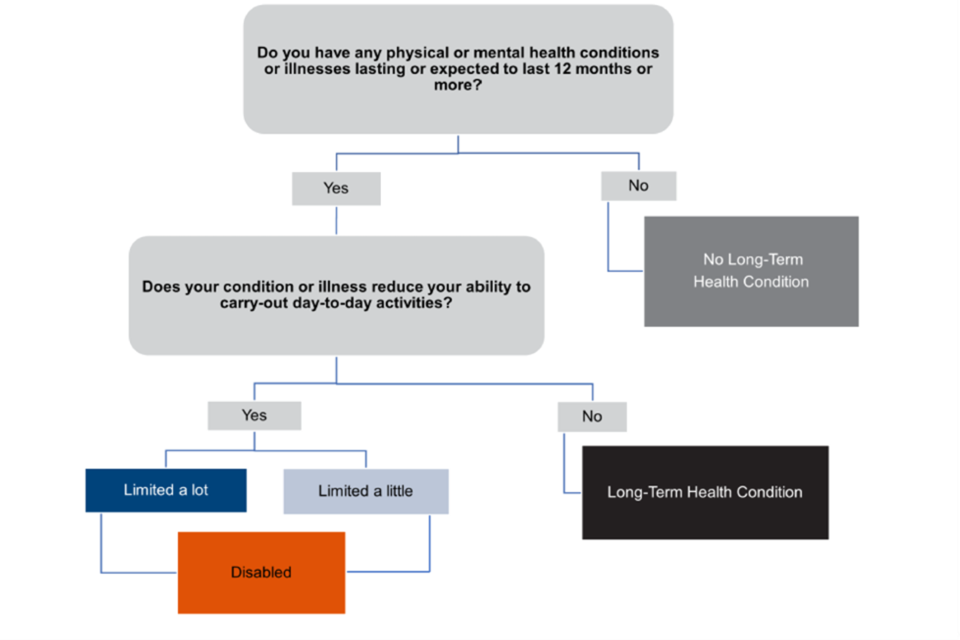
Less than 1% of the working-age population either don’t know or don’t answer both questions so have an unknown disability status.
Employment
Employment and other labour market concepts used in this release are defined in the same way as National Statistics published by the Office for National Statistics (ONS) in their Labour Market Overview. This in turn follows internationally agreed guidelines set out by the International Labour Organisation (ILO).
Seasonality
Quarterly estimates in this release are not seasonally adjusted. When comparing non-seasonally adjusted data over time it is best practice to compare the same 3-month period for different years (for example, compare April to June 2013 with April to June 2024 but do not compare April to June 2013 with January to March 2024).
Data sources
Full definitions are given in the background information and methodology. Estimates in this release are based on versions of the Annual Population and Labour Force Surveys using the latest population weights. Annual Population Survey (person) data uses older population totals, aligned with the LFS approach which had been used prior to the partial reweighting first published in February 2024. For more information, see Labour market transformation – update on progress and plans - Office for National Statistics.
The reweighted Labour Force Survey (LFS) quarterly estimates incorporate the latest estimates of the size and composition of the UK population, improving the representativeness of the LFS estimates. The ONS have only been able to reweight LFS data from July to September 2022 onwards. The reweighting exercise creates a discontinuity between December 2018 to February 2019 and January to March 2019 where there will be a step change in LFS estimates. However, the overall direction of long-term trends may still hold despite the break in the series. Nonetheless, the ongoing challenges with response rates and levels mean that ONS publish LFS-based labour market statistics as official statistics in development until further review. This is also in line with the letter from the Office for Statistics Regulation (OSR), stating that LFS statistics should not be published as accredited official statistics until the OSR has reviewed them.
Reweighting does not address the volatility seen in recent periods which the ONS also expect to see to some extent going forwards. They therefore advise caution when interpreting short-term changes in headline rates and recommend using them as part of a suite of labour market indicators. These are official statistics in development. For more information on achieved sample sizes, see Labour Force Survey quality update – Office for National Statistics.
The Office for National Statistics (ONS) are transforming the Labour Force Survey to increase the sample size (making it more representative of the population as a whole) and improve the methods for collecting data, including the flexibility to quickly change the questions so that they reflect the key needs of the day. The survey will move to an on-line first approach, supported by telephone collection and ‘knock to nudge’. This should provide more robust insights on the detailed characteristics of those within and outside work. The latest update on progress can be found at: Labour market transformation – update on progress and plans – Office for National Statistics.
Statistical significance
All results in the commentary are statistically significant at the 95% level, unless stated. Differences in employment of groups with given characteristics are not necessarily caused by those characteristics.
We can use statistical significance to decide whether we think a difference between two survey-based estimates reflects a true change in the population rather than being attributable to random variation in our sample selection.
Statistical significance helps us to establish what observed changes or relationships we should pay attention to, and which apparent changes may have occurred only because of randomness in the sampling.
Rounding
Figures contained within this release are subject to rounding so may not sum to 100%, unless otherwise stated. The level of rounding applied, which is dependent on the magnitude of the figure being quoted, can be found in the background information and methodology.
Accessibility
The supplementary data tables accompanying this release have been developed using Government Statistical Service (GSS) guidance on releasing statistics in spreadsheets.
4. Measures
This section looks at the three main measures used to monitor disability employment of the working-age population:
-
the (absolute) number of disabled people in employment
-
the disability employment rate (the number of disabled people in employment divided by the number of disabled people)
-
the difference between the employment rates of disabled and non-disabled people (known as the disability employment gap)
Trends for each measure, starting from April 2013, when the current definition of disability began, are shown in Figures 2 to 4. The components or factors that may influence these measures are examined in Figure 5.
The number of disabled people in employment continues to rise
Figure 2: Number of disabled people in employment, people aged 16 to 64, UK, April to June 2013 to April to June 2024
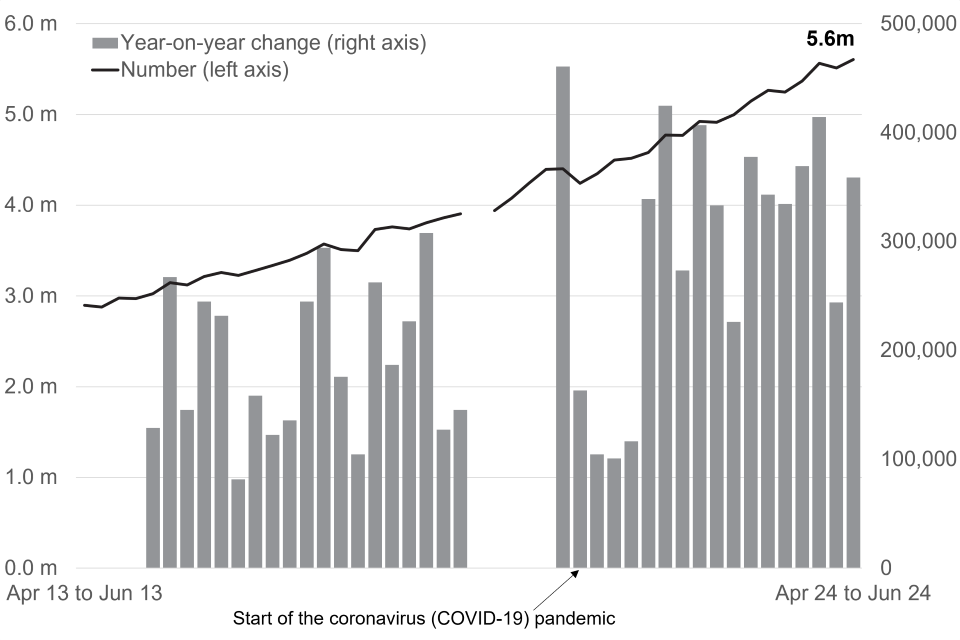
Source: Labour Force Survey – data and definitions can be found in supplementary data table MSR001.
Note: The ONS have only reweighted LFS data from January to March 2019 onwards with the latest estimates of the size and composition of the UK population. Data prior to and from January to March 2019 are not directly comparable.
The longer-term increases in disability employment can be linked to 4 main factors:
- disability prevalence
- disability employment gap
- non-disabled employment rate
- working-age population
See Figure 5 for more details.
The disability employment rate has yet to return to its pre-pandemic level
Figure 3: Disability employment rate, people aged 16 to 64, UK, April to June 2013 to April to June 2024
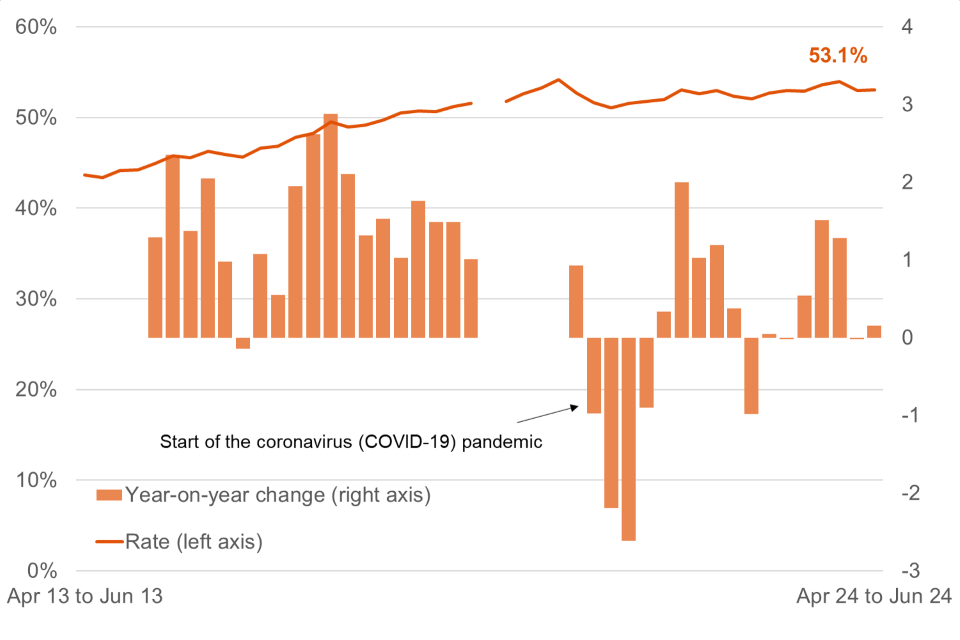
Source: Labour Force Survey – data and definitions can be found in supplementary data table MSR001.
Note: The ONS have only reweighted LFS data from January to March 2019 onwards with the latest estimates of the size and composition of the UK population. Data prior to and from January to March 2019 are not directly comparable.
The disability employment rate reached a pre-pandemic high of 54.2% in October to December 2019. The rate is yet to return to its pre-pandemic level and was 54.0% in the same quarter in 2023.
The latest quarter (April to June 2024) showed the rate increased by 0.2 percentage points (compared to the same quarter last year), however this increase is not statistically significant.
Historical downward trends in the disability employment gap have slowed in the last four years
Figure 4: Disability employment gap (percentage point), people aged 16 to 64, UK, April to June 2013 to April to June 2024
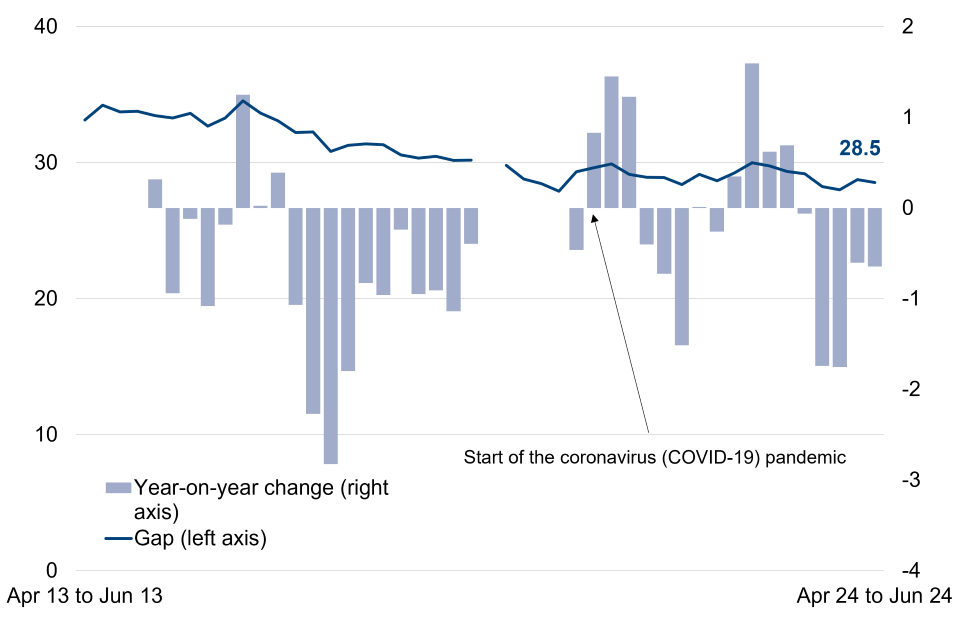
Source: Labour Force Survey – data and definitions can be found in supplementary data table MSR001.
Note: The ONS have only reweighted LFS data from January to March 2019 onwards with the latest estimates of the size and composition of the UK population. Data prior to and from January to March 2019 are not directly comparable.
The disability employment gap started to widen (year-on-year) at the start of the coronavirus (COVID-19) pandemic. In the latest quarter (April to June 2024) the disability employment gap decreased by 0.3 percentage points since the same quarter in 2019 (this change is not statistically significant).
There have been some signs of the gap narrowing again, the latest quarter (April to June 2024) showed the gap decreased by 0.6 percentage points compared to the same quarter last year (this is not statistically significant). This was driven partly by a small rise in the disability employment rate (0.2 percentage points) but mainly due to a decrease in the non-disabled employment rate (0.5 percentage points).
The increasing number of disabled people in employment is associated with four main components of change
There are four main components of change in the number of disabled people in employment:
-
overall working-age population: this only includes people aged 16 to 64 who report their disability status
-
disability prevalence: the proportion of the working-age population who report they are disabled
-
non-disabled employment rate: the proportion of non-disabled people who are in employment
-
disability employment gap: the difference between employment rates of non-disabled and disabled groups
Each of these factors has contributed to the increased number of disabled people in employment since 2013/14. However, it is not possible to directly measure the impact of each component because they interact with each other.
These estimates are intended to give a broad indication of the impact of the different components. They tell us about the components of change, but not the causes. Neither do they capture all interactions. For example, an increase in disability prevalence could impact the disability employment gap, even without any changes in employment, if prevalence increased faster among those already in work than among those out of work.
The increasing number of disabled people in employment is most associated with rising disability prevalence
Figure 5: Number of disabled people in employment by component of change, people aged 16 to 64 years, UK, 2013/14 to 2023/24
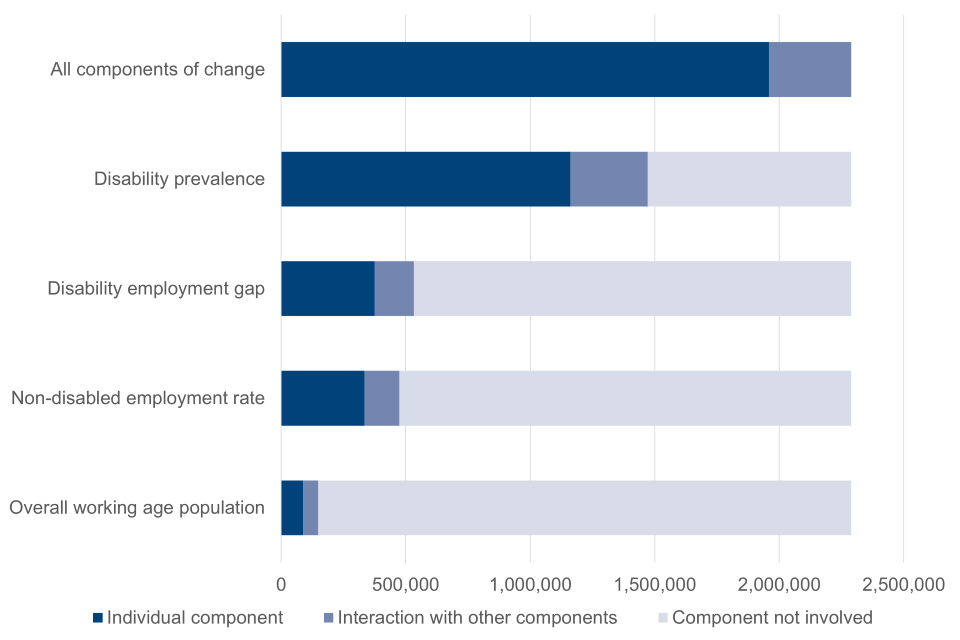
Source: Annual Population Survey – data and definitions can be found in supplementary data table MSR002.
Figure 5 shows how much of this increase may be attributed to the four components of change. For each component, a range is given. The lower end of the range shows the estimated impact of that component in isolation (dark blue bar); the upper end gives the impact including all interaction effects with the other components (mid-blue bar) and the light blue shaded area is any increase where the component is not involved. Therefore, the same interaction effects can appear in the chart under more than one component. However, taken as a whole, these interactions had a relatively small impact.
For an example calculation, and for more information on the method applied to calculate the components of change, see the background information and methodology.
The number of disabled people in employment has increased by 2.3 million since 2013/14. The impact of each component on the increase in the number of disabled people in employment is estimated as around:
-
60% for increased disability prevalence (1,160,000 to 1,470,000)
-
20% for decreased disability employment gap (380,000 to 530,000)
-
20% for increased non-disabled employment rate (330,000 to 470,000)
-
5% for increased working age population (90,000 to 150,000)
The increase in disability prevalence is associated with an increase in people reporting mental health conditions and “other health problems or disabilities” as a main or secondary condition. This is covered in more detail in the ‘Populations’ section.
International Comparisons
The OECD released a report in October 2022 that looked at rates of disability prevalence and employment across OECD nations. This showed that the disability employment gap in the UK had narrowed between 2012-2015 and 2016-2019 unlike in most other OECD countries. However, the UK gap was still above the OECD average in 2016-2019.
However, caution should be used when making direct comparisons regarding disability statistics between countries due to differences in disability definitions and population demographics, as well as stigma, perception, and awareness of disability across countries and within countries over time.
5. Populations
This section looks at how the working-age population has changed over the last 10 years. In particular, the changes in the number of people who report having a long-term health condition or are classed as disabled, and how these are associated with different demographics.
Nearly one in four of the working-age population are classed as disabled
Figure 6: Proportion of the population with a long-term health condition, or classed as disabled, including those limited a lot, people aged 16 to 64 years, UK, 2023/24
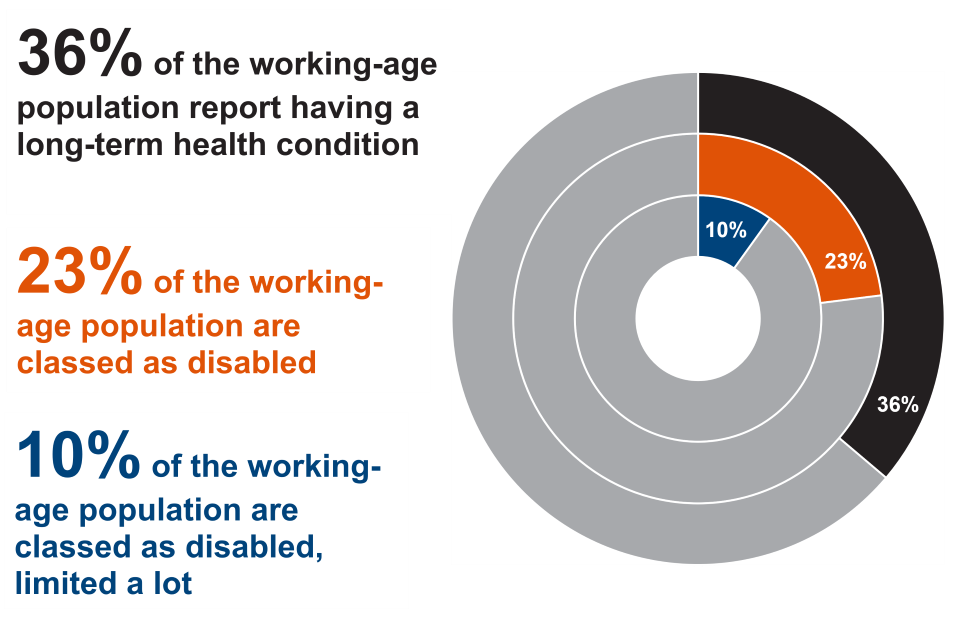
Source: Annual Population Survey – data and definitions can be found in supplementary data table POP001.
For more information on the measurement of disability, see Review of disability data harmonised standards.
The number of people reporting a long-term health condition or classed as disabled continues to rise
Figure 7: Number of people with a long-term health condition, or classed as disabled, including those limited a lot, people aged 16 to 64, UK, 2013/14 to 2023/24
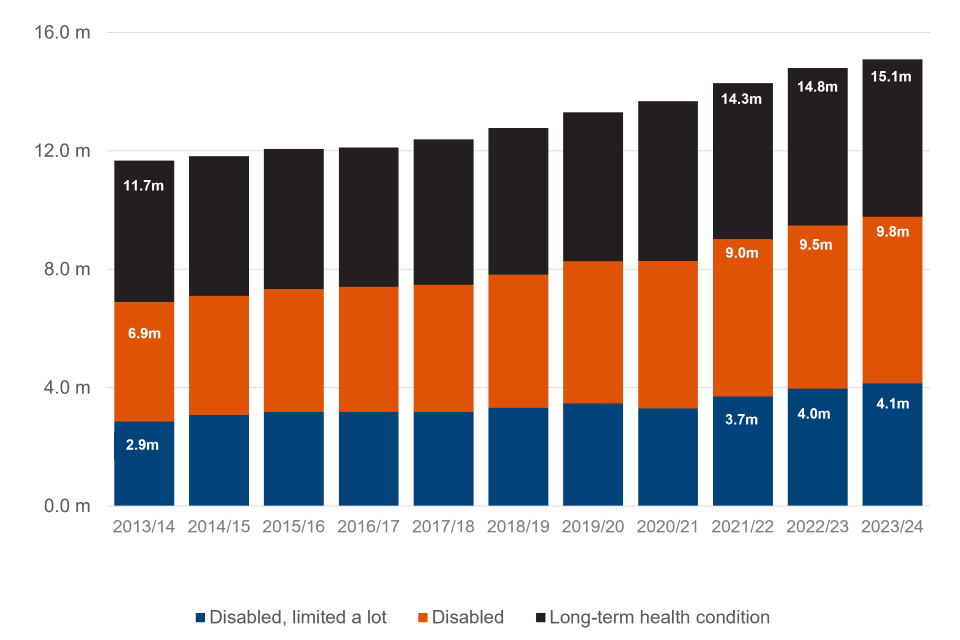
Source: Annual Population Survey – data and definitions can be found in supplementary data table POP001.
The working-age population in the UK (aged 16 to 64 years) has increased by 1.2 million (2.9%) in the last 10 years from 40.6 million (2013/14) to 41.7 million (2023/24). Annual Population Survey figures are not reweighted to the most recent population estimates, but overall trends are expected to be unaffected.
By comparison, between 2013/14 and 2023/24, the number of people reporting a long-term health condition increased by 3.4 million (29.3%). Of those with a long-term health condition, the number of people who reported their condition limited their day-to-day activities (classifying them as disabled) increased by 2.9 million (41.9%). Of those, the number who reported their day-to-day activities were limited a lot, increased by 1.3 million (45.1%).
The period of 2023/24 saw an increase in the number of people reporting a long-term health condition (by 300,000 or 2.0%), classified as disabled (by 290,000 or 3.1%) and disabled, limited a lot (by 170,000 or 4.4%). However, the increase has been slower in 2023/24 compared to the previous two years. The increase in 2021/22 was the largest annual increase since 2013/14 in the number of people reporting a long-term health condition (610,000 or 4.4%), classified as disabled (730,000 or 8.8%) and disabled, limited a lot (410,000 or 12.3%).
These trends are expected to continue. The Health Foundation projects the number of people (in England) living with major illness is expected to increase by 37% – over a third – by 2040, nine times the rate at which the working age population (20–69-year-olds) is expected to grow (4%). For more information, see Health in 2040: projected patterns of illness in England.
The longer-term increase in the number of disabled people could be due to several factors, including changes in public awareness and attitudes towards disability. However, we have seen in other functional-based surveys (which do not rely on people self-reporting disability), that these are not the only factors. For example, the Adult Psychiatric Morbidity Survey (APMS) shows increases in prevalence for some conditions which may be due to changes in society and health, including behaviours associated with diet and levels of physical activity. The latest version of the APMS was for 2014 with the next version currently in the field.
The increase in disability prevalence is associated with an increase in people reporting mental health conditions and “other health problems or disabilities”.
Musculoskeletal (MSK) conditions include problems or disabilities connected with the arms, hands, legs, feet, back or neck. Mental health (MH) conditions include depression, bad nerves, anxiety, mental illness or other nervous disorders.
The number of disabled people with a mental health condition as their main condition has increased by 1.2 million (97.4%) between 2013/14 and 2023/24. This is mainly from people reporting depression, bad nerves or anxiety which saw an 880,000 (106.1%) increase. There has also been a large increase in people reporting “other” health problems or disabilities (890,000 or 129.1%) between 2013/14 and 2023/24, the majority of which has occurred since 2019/20.
This compares to musculoskeletal conditions which have shown a decrease of 2,000 (0.1%) for disabled people in the same period, although this is not statistically significant. This varies by condition, with problems or disabilities connected with arms or hands increasing by 16.9% and problems or disabilities connected with back or neck decreasing by 7.0%. However, people with problems or disabilities connected with back or neck still makes up 41.9% of all people who reported a musculoskeletal condition as their main health condition in 2023/24. Despite the numbers falling, there are still 2.4 million disabled people (24.4%) whose main health condition is musculoskeletal.
Many disabled people have more than one health condition which may limit their activity, that won’t be captured in the analysis of their main health condition. Some changes over time in main condition may reflect changes in the relative impacts of pre-existing conditions rather than the onset of new conditions. For example, there are 1.6 million disabled people (16.3%) who report having both a mental health and a musculoskeletal condition.
Data for all health conditions is provided in the supplementary tables should alternative breakdowns be required.
The increase in the number of people being classed as disabled since 2013/14 has been greater for:
-
females, 1.8 million (48.6%) increase, compared to males, 1.1 million (33.7%)
-
younger people (aged 16 to 34), 1.5 million (86.3%) increase compared to older people (aged 35 to 64), 1.4 million (27.4%)
Figure 8: Change in the number of disabled people by age, sex and main health condition (MSK and MH only), people aged 16 to 64, UK, 2013/14 to 2023/24
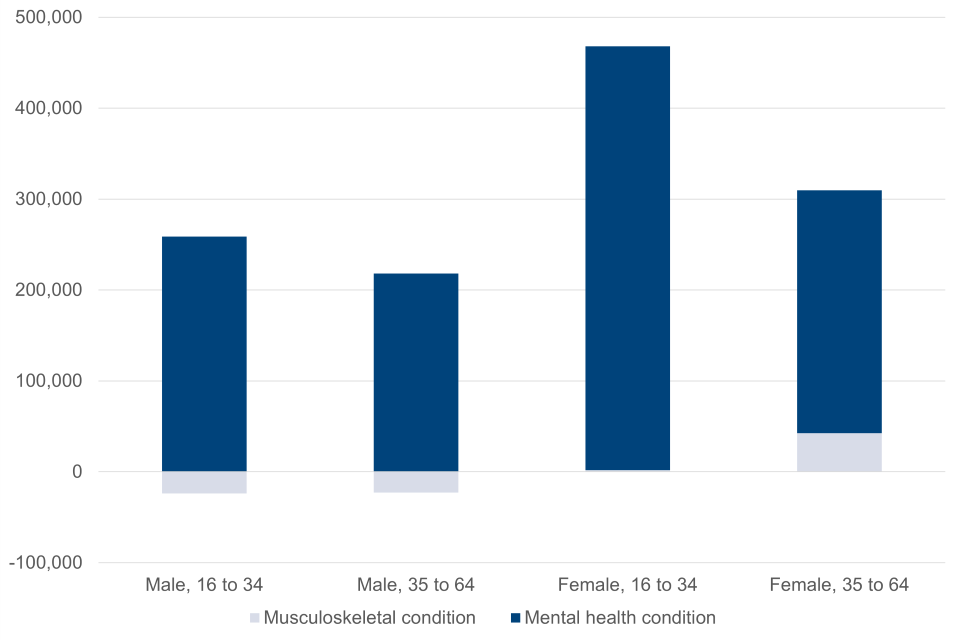
Source: Annual Population Survey – data and definitions can be found in supplementary data table POP002.
Since 2013/14, the largest increases across the age, sex and health condition groups shown in Figure 8 were for females aged 16 to 34 with a mental health condition (as their main condition) who saw an increase of 470,000 (180.3%).
Independent research released by the Office for National Statistics (ONS) in December 2022, using the Opinions and Lifestyle Survey (OPN), examined instances of moderate to severe depressive symptoms in Autumn 2022 amongst adults in Great Britain, providing a range of sub-analyses on predictors of depressive symptoms. Read more in Cost of living and depression in adults, Great Britain - Office for National Statistics (ons.gov.uk).
This found that around 1 in 6 (16%) adults experienced moderate to severe depressive symptoms; this is similar to rates found in Summer 2021 (17%), but higher than pre-pandemic levels (10%). When comparing within population groups, prevalence of moderate to severe depressive symptoms was higher among adults who were economically inactive because of long-term sickness (59%), unpaid carers for 35 or more hours a week (37%), disabled adults (35%), adults in the most deprived areas of England (25%), young adults aged 16 to 29 years (28%) and females (19%).
More information on mental health statistics can be found in the House of Commons Library summary, which provided further context, on “Mental health statistics: prevalence, services and funding in England” in March 2024. This asks “How common are mental health conditions? How long do people wait to access NHS therapy for depression and anxiety? Do statistics show that mental health services work for everyone? How much is spent on mental health services?”
Some long-term health conditions are associated with a greater impact on a person’s day-to-day activities
Figure 9: Proportion of people with a long-term health condition, or classed as disabled, including those limited a lot, by main health condition, people aged 16 to 64 years, UK, 2023/24
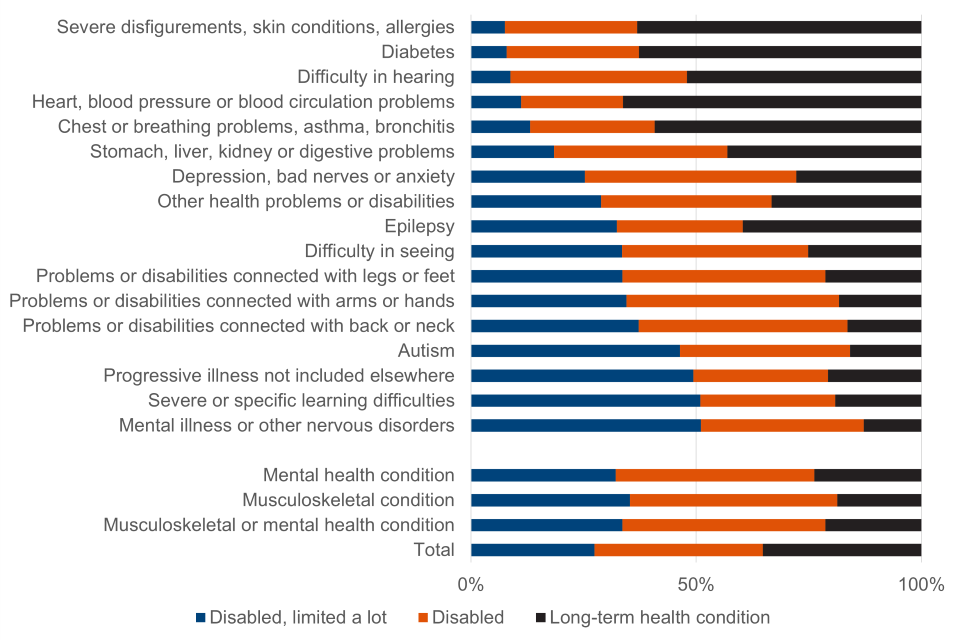
Source: Annual Population Survey – data can be found in supplementary data table POP003.
Data for all main and secondary health condition is provided in supplementary data table POP004 should alternative breakdowns be required.
There are large differences on the impact a person’s main long-term health condition has on their day-to-day activities. For example, 7.5% of those who reported severe disfigurements, skin conditions or allergies as their main condition, said it affected their day-to-day activities a lot. In comparison, 49.4% of people with a progressive illness (not included elsewhere), 50.9% of those with severe or specific learning difficulties and 51.0% of those with mental illness or other nervous disorders said it affected their day-to-day activities a lot.
People with a mental health condition as their main long-term health condition were less likely to report that it limited their day-to-day activities a lot compared to people with a musculoskeletal condition (32.2% compared to 35.3%).
However, there is a large difference between the different groupings that make up the mental health condition figure. Of the people who reported depression, bad nerves, or anxiety, 25.3% said their condition limited their day-to-day activities a lot. This compares to people with a mental illness or other nervous disorder where around twice this figure (51.0%) said their day-to-day activities were limited a lot. This group makes up 26.8% of people who have a long-term health condition and report a mental health condition as their main condition.
Estimates for some long-term health conditions are based on small sample sizes and therefore subject to a higher degree of uncertainty. Sample sizes for all main long-term health conditions can be found in supplementary data table POP003U. The equivalent data for main or secondary long-term health conditions can be found in supplementary data table POP004 and supplementary data table POP004U.
6. Labour market status
This section looks at the labour market status of individuals, specifically whether they are in employment or not. Employment is defined as anyone who has done one or more hour of paid work and those who have a job that they are temporarily away from (for example, because they are on holiday or off sick).
The largest two categories within employment are employees and self-employed people; in recent years these two categories have accounted for most of the people in employment. People who are not in employment will be either unemployed or economically inactive.
These breakdowns are shown for different characteristics, by disability status and over time.
The disability employment gap increases with age
Figure 10: Proportion of people in employment by disability status and age, people aged 16 to 64 years, UK, 2023/24
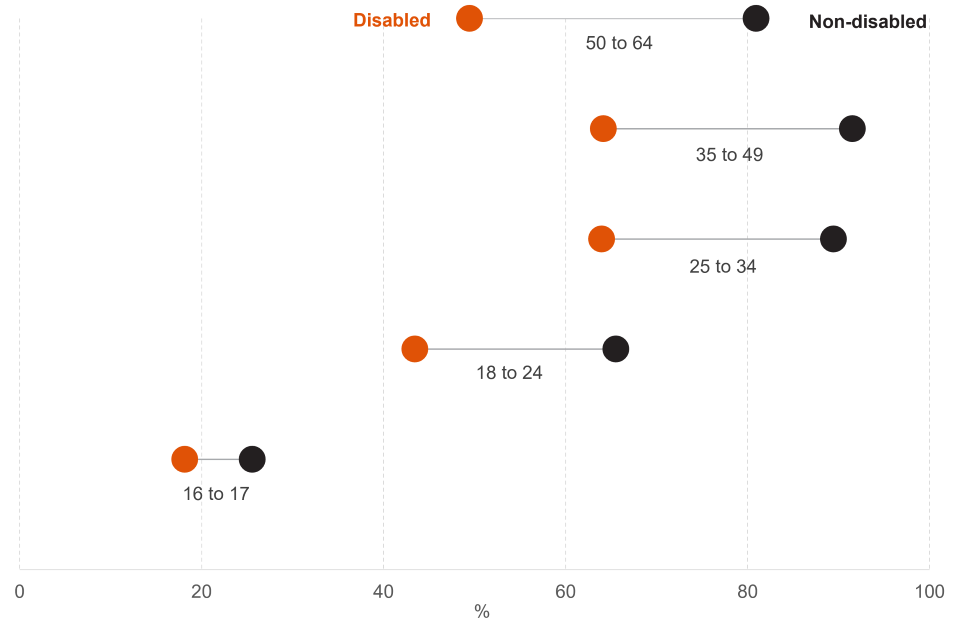
Source: Annual Population Survey – data and definitions can be found in supplementary data table LMS001.
Employment rates for disabled people, across all ages, are lower than those of non-disabled people. For both disabled and non-disabled people, employment rates generally increase with age up to the age of 50, where they start to decrease. 16 to 17-year-olds have the lowest employment rates but this is because they are more likely to be in education or training than in employment.
The disability employment gap increases with age, with those aged 50 to 64-years-old having the largest gap (31.5 percentage points compared with 22.1 percentage points for 18 to 24-year-olds).
The age-profile of the disabled population is skewed towards older individuals. For example, the 50 to 64-year-old age group makes up over 40% of the working-age disabled population, whilst the 18 to 24-year-old age group makes up just over 10% of the working-age disabled population. In comparison, the 50–64-year-old age group makes up approximately 30% of the non-disabled working-age population.
Disabled females are as likely to be in employment as disabled males
Figure 11: Proportion of people in employment by sex, disabled people aged 16 to 64 years, UK, 2013/14 to 2023/24
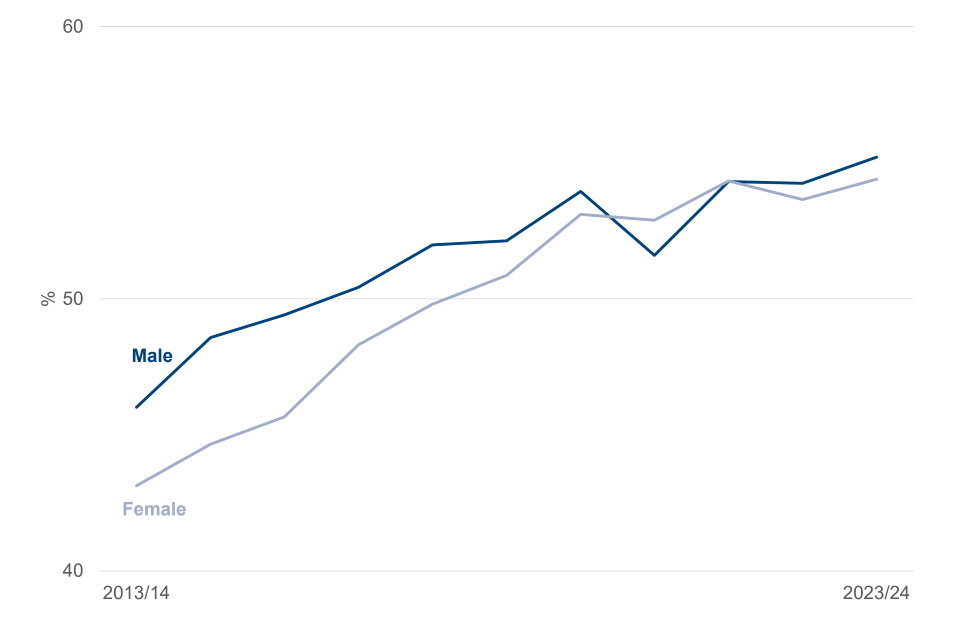
Source: Annual Population Survey – data and definitions can be found in supplementary data table LMS002.
The gap between the employment rates of disabled females and males has been closing for several years. The rate for disabled males in 2023/24 was estimated at 55.2%, marginally greater than for disabled females at 54.4%, but this difference is not statistically significant. This follows 2022/23, where the employment rate for disabled males was marginally higher than females, by 0.6 percentage points. Once again, this difference was not a statically significant difference. The parity between males and females contrasts with non-disabled people, where in 2023/24, females had an employment rate of 78.5% compared to 85.1% for males, a difference of 6.6 percentage points.
The employment rate for disabled females has increased by 11.3 percentage points since 2013/14, up from 43.1%, with the rate for males increasing more slowly - by 9.2 percentage points from 46.0% in 2013/14.
Given the greater employment rate of non-disabled males compared to non-disabled females, the disability employment gap is narrower for females (24.1 percentage points compared to 29.9 percentage points for males).
However, the gap has closed for both males and females by 0.8 percentage points in the last year. The gap has closed at a greater rate for males than females since 2013/14 (4.7 percentage points for females and 6.2 percentage points for males).
Disabled people with a musculoskeletal condition are more likely than those with a mental health condition to be in employment
Figure 12: Proportion of people in employment by main or secondary health condition, people aged 16 to 64 years, UK, 2023/24
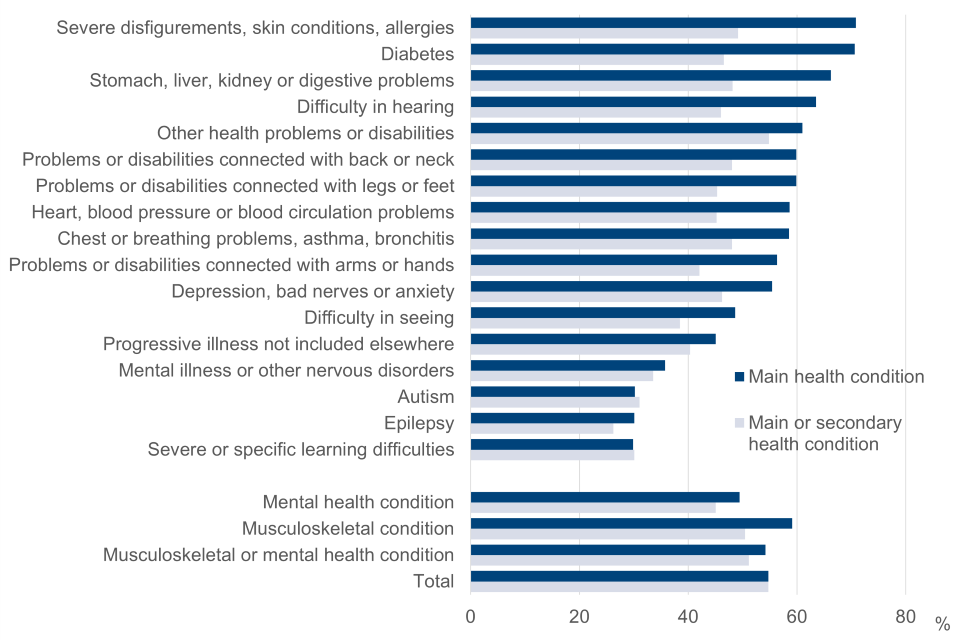
Source: Annual Population Survey – data and definitions can be found in supplementary data tables LMS003 and LMS004.
Musculoskeletal (MSK) conditions include problems or disabilities connected with the arms, hands, legs, feet, back or neck. Mental health (MH) conditions include depression, bad nerves, anxiety, mental illness or other nervous disorders.
Data for all health conditions is provided in the supplementary tables, should alternative breakdowns be required.
There is a lot of variation in employment rates of disabled people for different health conditions. For example, in 2023/24, people whose main health condition is severe disfigurements, skin conditions or allergies are over twice as likely to be in employment compared to someone whose main health condition is severe or specific learning difficulties (70.8% compared to 29.9%). Disabled people with a musculoskeletal condition are more likely than those with a mental health condition to be in employment (59.1% compared to 49.4% where it is the main condition). However, 1.6m (or 16.3% of disabled people) report having both a musculoskeletal and a mental health condition.
Employment rates for health conditions where the condition is secondary are generally lower than those for main conditions. This is because people with a secondary condition will, by definition, have more than one health condition. We know that the more health conditions a person has the less likely they are to be in employment (see supplementary data table LMS005).
The likelihood a health condition impacts day-to-day activities is associated with the likelihood of being in employment
Figure 13: Proportion of disabled people in employment by proportion of individuals whose main condition limits their day-to-day activities a lot, people aged 16 to 64, UK, 2023/24
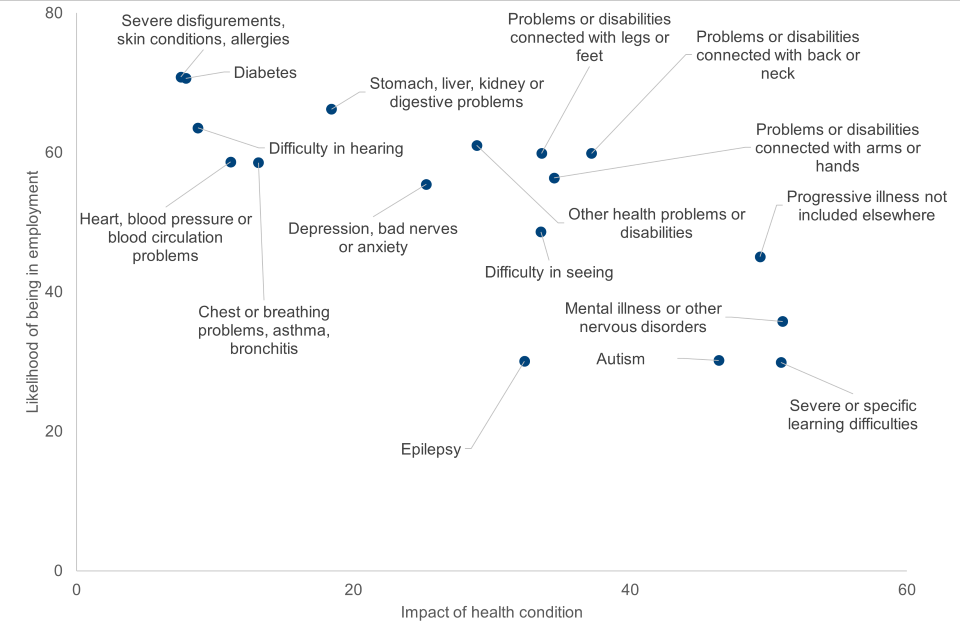
Source: Annual Population Survey – data and definitions can be found in supplementary data tables POP003 and LMS003.
The difference in employment rates for different conditions is associated with the effect the condition has on a person’s day-to-day activities i.e., the greater the impact the lower chance they have of being in employment and vice-versa. Figure 13 displays a strong negative correlation (-0.7) between the employment rates of disabled people by main condition and the proportion of people with that condition who report that it limits their day-to-day activities “a lot”. A strong correlation does not necessarily mean that the impact of a health condition causes a person to be in or not in employment. This is because the impact of the health condition is unlikely to be the only factor impacting on the likelihood of being in employment.
For example, 51.0% of people with mental illness or other nervous disorders reported their main condition affected their day-to-day activities “a lot” - the highest proportion across the different long-term health conditions. However, people with this condition do not have the lowest likelihood of being in employment (see supplementary data table POP003). Furthermore, Figure 13 shows that people with Epilepsy, or Autism, or Severe or specific learning difficulties as their main condition have varying levels of impact of the health condition despite having a similar likelihood of being in employment.
Disabled people with one health condition are more than twice as likely to be in employment than those with five or more conditions
Figure 14: Proportion of people in employment by number of health conditions, people aged 16 to 64 years, UK, 2023/24
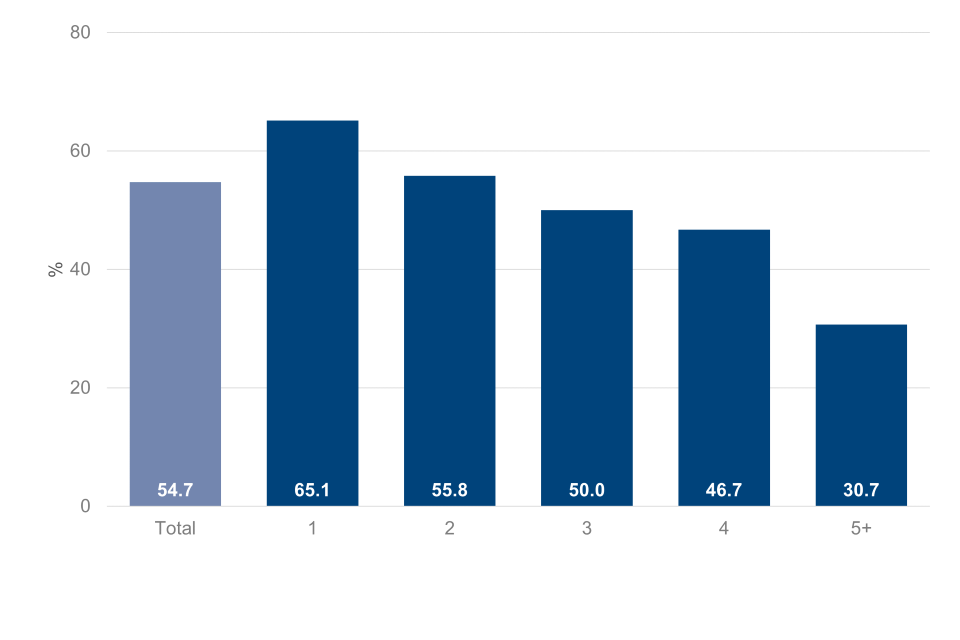
Source: Annual Population Survey – data and definitions can be found in supplementary data table LMS005.
The proportion of disabled people reporting more than one long-term health condition was generally falling prior to the coronavirus (COVID-19) pandemic - from 60.5% in 2013/14 to 55.7% in 2019/20. In 2020/21 the proportion increased to 60.1%, and fell to 56.3% in 2023/24, remaining higher than the pre-pandemic figure.
In 2023/24, 65.1% of disabled people with one health condition were in employment. This employment rate continues to increase (from 57.4% in 2013/14) and is 10.4 percentage points higher than the rate for all disabled people. Employment rates decline as the number of health conditions increases. Less than a third (30.7%) of disabled people with five or more health conditions were in employment in 2023/24.
Non-disabled people with no formal qualifications are as likely to be employed as disabled people with a highest qualification at A Level
Figure 15: Proportion of people in employment by disability status and highest qualification, people aged 16 to 64, UK, 2023/24
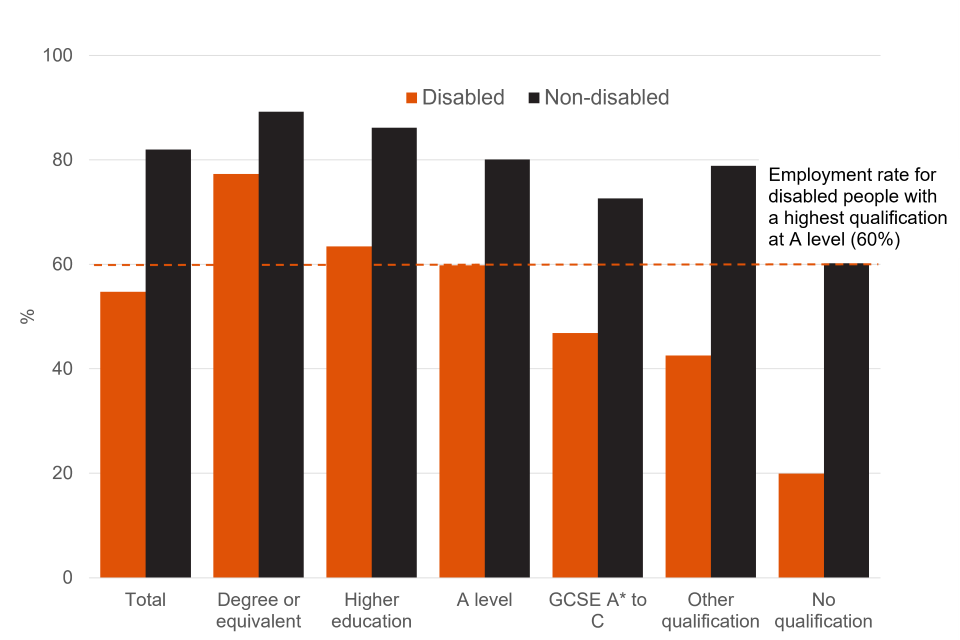
Source: Annual Population Survey – data and definitions can be found in supplementary data table LMS006.
In educational attainment, disabled people are less likely to have a degree or equivalent qualification than non-disabled people (25.8% for disabled people and 41.6% for non-disabled people), and more likely to have no qualifications (12.7% for disabled people and 4.7% for non-disabled people). However, since 2013/14, the proportion of disabled people reporting a degree as their highest qualification has risen by 10.5 percentage points, compared to a rise of 13.0 percentage points for non-disabled people.
Generally, the higher the qualification a person has the more likely they are to be in work. However, disabled people are less likely to be in work than non-disabled people at all qualification levels. Non-disabled people with a degree are around 11.9 percentage points more likely to be in work compared to their disabled counterparts. For those with no qualifications, the difference is three times greater with non-disabled people around 40.3 percentage points more likely to be in work. Disabled people with a highest qualification at A level are around as likely (59.8%) to be in employment as a non-disabled person with no qualifications (60.2%). Disabled people with a degree or higher education are more likely to be in employment than non-disabled people with no qualifications.
Further research on factors, including highest qualification, driving the disability employment gap can be found at: Unpacking the Disability Employment Gap The University of Sheffield.
Disabled people of Black/African/Caribbean/Black British and White ethnicity have the largest disability employment gaps
Figure 16: Proportion of people in employment by disability status and ethnicity, people aged 16 to 64 years, UK, 2023/24
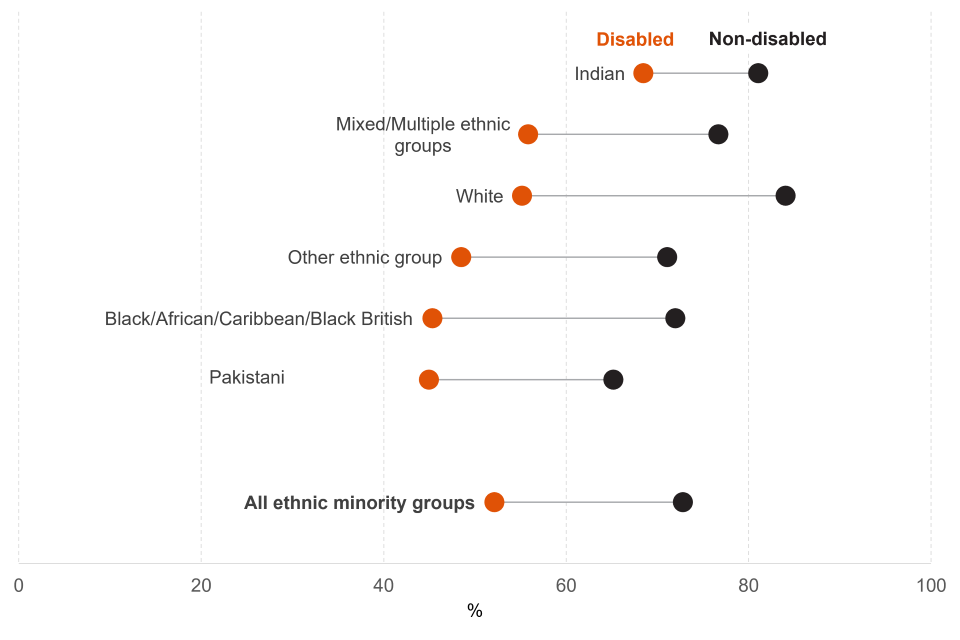
Source: Annual Population Survey – data and definitions can be found in supplementary data table LMS007.
Disabled people of all ethnicities are less likely to be in employment compared to their non-disabled counterparts. People of Indian ethnicity have the highest disability employment rate (68.5%) whilst people of Pakistani ethnicity have one of the lowest (44.9%).
Disabled people of Black/African/Caribbean/Black British have the largest disability employment gap (26.6 percentage points) for any ethnic minority group. This gap is lower than the disability employment gap for people of White ethnicity (28.9 percentage points). Historically, the White ethnic population has had the widest disability employment gap. This is due in part to them also having the highest non-disabled employment rate, which holds in 2023/24 at 84.0%. The disability employment gap for all ethnic minority (non-White) groups is 20.7 percentage points.
Estimates for Bangladeshi, Chinese and any other Asian background ethnic groups are based on small sample sizes and subject to a higher degree of uncertainty and are therefore not included in this analysis. The data for all groups can be found in supplementary data table LMS007.
Disabled people living in social rented accommodation have the widest disability employment gap compared with other types of housing tenure
Figure 17: Proportion of people in employment by disability status and housing tenure, people aged 16 to 64 years, UK, 2023/24
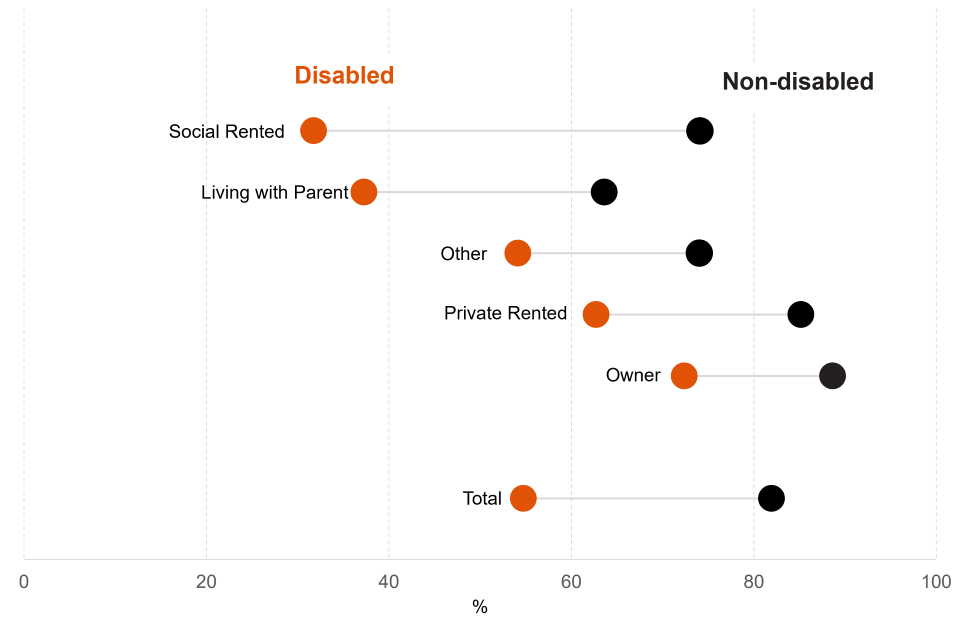
Source: Annual Population Survey – data and definitions can be found in supplementary data table LMS011.
Disabled people are less likely to own a home than non-disabled people (40.7% compared to 54.6%), and more likely to be living in social housing (24.2% compared to 7.1%). However, they are similarly likely to be privately renting or living with a parent.
Individuals who own their home are the most likely to be in work, regardless of their disability status (88.6% for non-disabled people and 72.4% for disabled people), followed by those living in private rented accommodation. Disabled people who are living with their parents, and disabled people living in social rented accommodation are less likely to be in employment compared with those living in other housing tenures.
However, disabled people are less likely to be in work across all tenures compared with non-disabled people. For example, non-disabled people living in a home they own are around 16.2 percentage points more likely to be in work compared to their disabled counterparts, the narrowest disability employment gap. For those living in social housing, the disability employment gap is widest, where non-disabled people living in social housing are 42.3 percentage points more likely to be in work compared to disabled people.
Disabled people not living in a couple are less likely to be employed and have a wider disability employment gap
Figure 18: Proportion of people in employment by disability and couple status, people aged 16 to 64, UK, April to June 2024
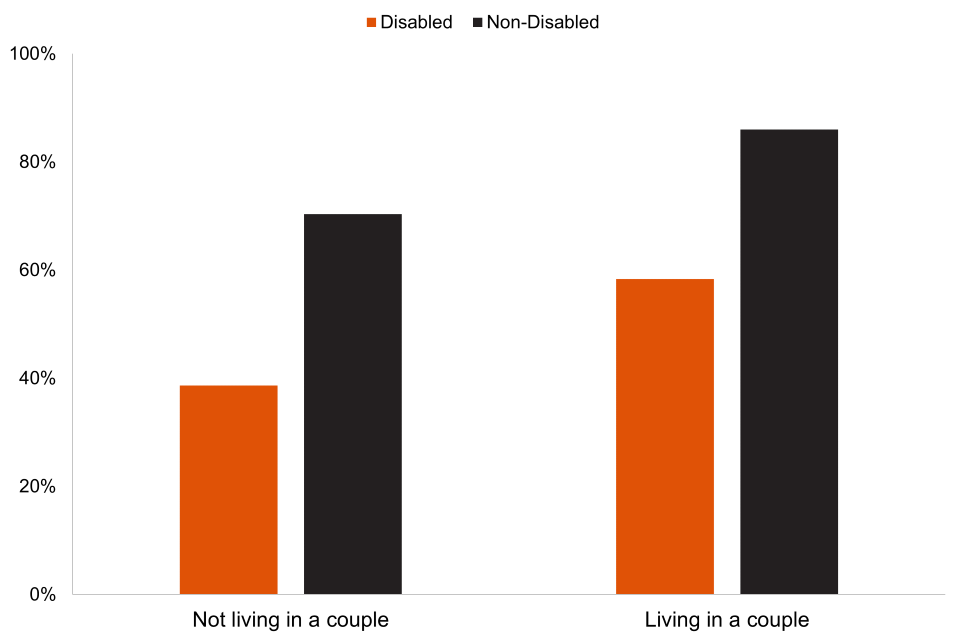
Source: Labour Force Survey – data and definitions can be found in supplementary data table LMS012.
In April to June 2024, disabled individuals were less likely to be living in a couple than non-disabled individuals (53.0% compared to 64.1%).
Living in a couple is related to higher employment, regardless of disability status. Disabled individuals who are living in a couple are more likely to be in employment than disabled individuals who do not live in a couple (65.5% compared to 41.6%). This result holds for non-disabled individuals, but the difference is less pronounced (88.3% for living in a couple compared to 69.8% for not living in a couple).
However, the disability employment gap is wider for individuals who do not live in a couple when compared to individuals who do live in a couple (28.1 percentage points compared to 22.7 percentage points).
Living in a couple includes people who are Single, Widowed or Divorced and co-habiting and people who are Married or in a Civil Partnership and are living with their partner.
Despite falling across most areas of the UK, there are still large differences in the disability employment gap in different parts of the country
Figure 19: Disability employment gap (percentage points) by country and region, people aged 16 to 64 years, UK, 2013/14 and 2023/24
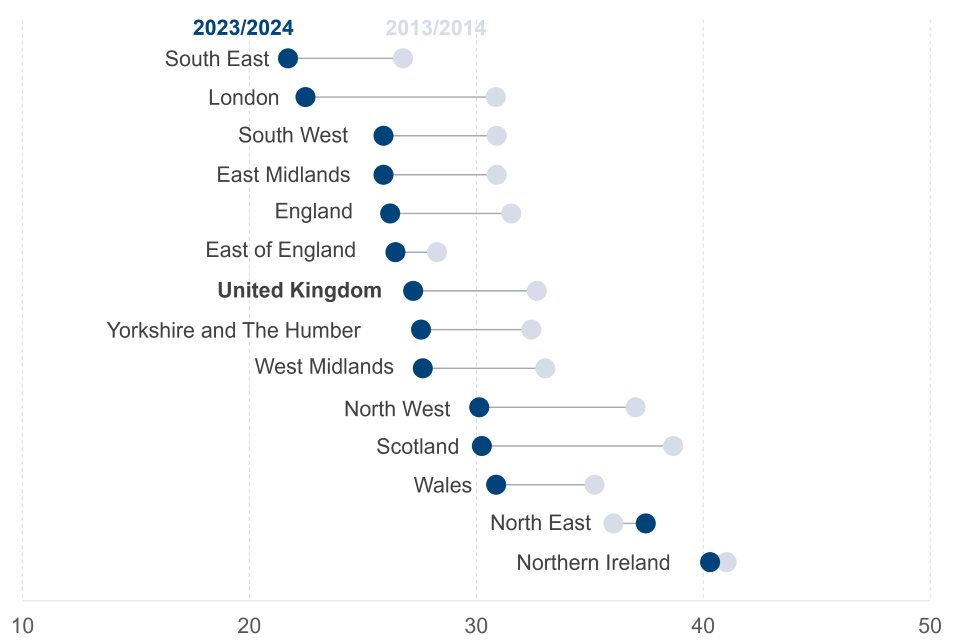
Source: Annual Population Survey – data and definitions can be found in supplementary data table LMS008.
All areas of the UK have seen a reduction in the disability employment gap between 2013/14 and 2023/24 except for the North East where the gap has increased by 1.4 percentage point, although this increase was not statistically significant.
The areas that ranked above the UK disability employment gap average in 2023/24 were Northern Ireland, North East and North West of England, West Midlands, Wales, Scotland and Yorkshire and The Humber. East Midlands, London, South West, South East, and East of England ranked below.
South East of England (3.0 percentage points reduction) is the area that has seen the largest reduction in the disability employment gap in the past 12 months, a statistically significant difference. East of England (3.2 percentage points increase) North East (2.6 percentage points) and West Midlands (2.1 percentage points) have seen the largest increases in the same period, although none of these changes are statistically significant.
Local authorities with the largest disability employment gaps tend to be concentrated within certain areas of the country
Figure 20: Disability employment gap (percentage points) by Local Authority, people aged 16 to 64 years, Great Britain, 2020 to 2022
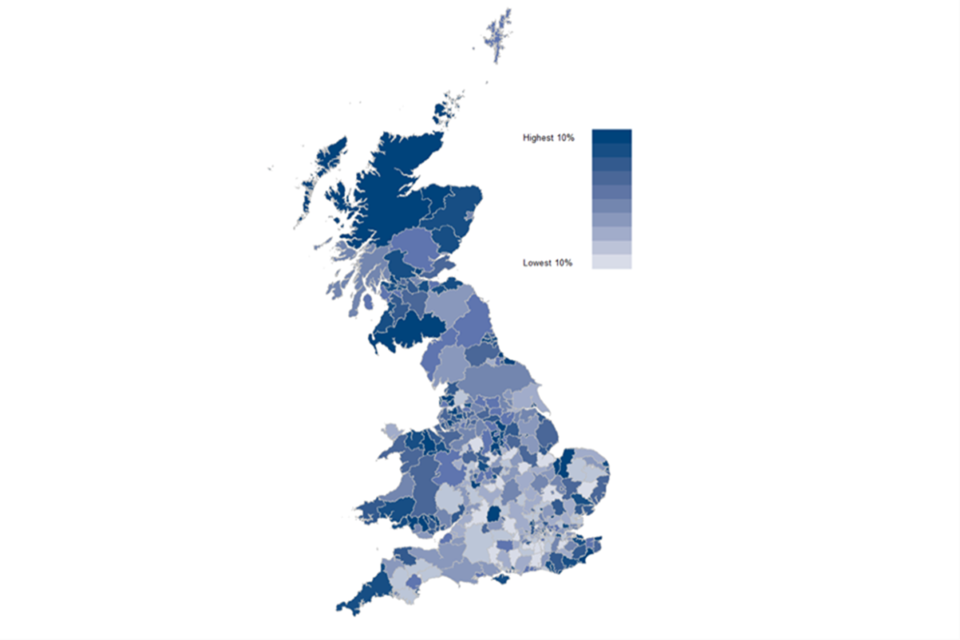
These estimates are based on survey data. In general there is a higher degree of uncertainty around estimates at a Local Authority level because at this granular level the sample sizes are small. Historic level trends can be volatile.
Source: Annual Population Survey – data and definitions can be found in supplementary data table LMS009.
Local Authorities with the largest disability employment gaps can be found across most regions and countries of the UK. However, many of these are concentrated in Scotland, Wales, and the North East of England. For example, Local Authorities with the largest (top 20%) disability employment gaps include the Highlands and Moray in Scotland (44.5 and 40.0 percentage points), Blaenau Gwent and Merthyr Tydfil in Wales (46.8 and 43.9 percentage points) and Redcar and Cleveland in the North East of England (38.8 percentage points).
In contrast, Local Authorities with the smallest disability employment gaps tend to be found in the South and East of Great Britain. Local Authorities with the lowest disability employment gap (bottom 20%) include Exeter (3.3 percentage points), Horsham (5.5 percentage points) and East Hampshire (6.9 percentage points), amongst others.
Research conducted by the Office for National Statistics (ONS) used 2021 census data to analyse health and disability, identifying higher rates of prevalence in parts of the North of England, the Midlands and Wales. The research paper proposes that geographic disparities in health outcomes may be connected to the legacy of the industrial revolution. This research used age-standardisation to account for the age-profile of the area when analysing prevalence.
Further research on factors, including geography, driving the disability employment gap can be found at: Unpacking the Disability Employment Gap, The University of Sheffield.
Data for Northern Ireland is not available below country level and is therefore not shown in the Local Authority map above (Figure 20). Data for all Local Authorities, regions and countries of the UK, including Northern Ireland, can be found in supplementary data table LMS009. The equivalent data for Parliamentary Constituencies can be found in supplementary data table LMS010.
7. Employment
This section looks at differences between disabled and non-disabled people who are in employment.
Disabled workers are more likely to work in the Health, Retail and Education industries
Figure 21: Percentage of people employed in each industry by disability status, people aged 16 to 64 years, UK, 2023/24
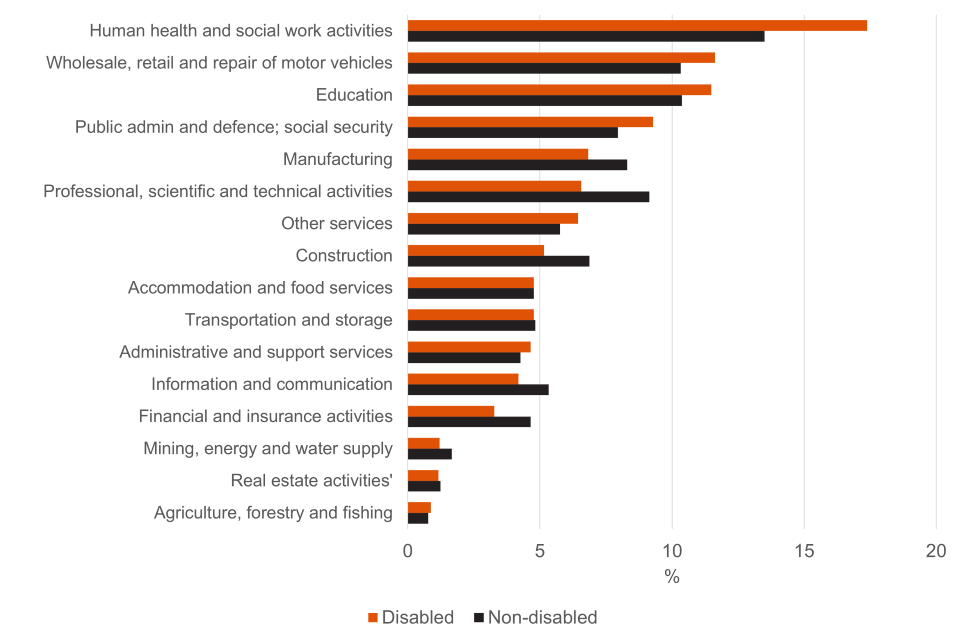
Source: Annual Population Survey – data and definitions can be found in supplementary data table EMP001.
In 2023/24 both disabled and non-disabled workers (including those who are self-employed) were most likely to be working in the following industries:
-
Human health and social work activities
-
Wholesale, retail and repair of motor vehicles
-
Education
These three industries made up 40.5% of disabled people in employment and 34.2% of non-disabled people in employment. Disabled people are disproportionately more likely to work in these industries compared to non-disabled people.
Since 2013/14, the proportion of non-disabled people working in Professional, scientific and technical activities has increased by 2.1 percentage points to 9.1% in 2023/24, compared with disabled people where it increased by 0.7 percentage points to 6.6%.
The industries, in 2023/24, where disabled workers were most likely to be under-represented, compared with non-disabled workers, are:
-
Professional, scientific and technical activities (6.6% of disabled workers compared to 9.1% of non-disabled workers)
-
Construction (5.2% compared to 6.9%)
-
Manufacturing (6.8% compared to 8.3%)
-
Financial and insurance activities (3.3% compared to 4.6%)
-
Information and communication (4.2% compared to 5.3%)
When analysing the age and sex demographics of disabled workers by industry, the notable differences (which were also seen for non-disabled workers) were:
-
Accommodation and food services (8.2% of disabled workers aged 16-34 compared with 3.2% of disabled workers 35-64)
-
Education (6.4% of disabled working males compared to 15.3% of disabled working females)
-
Human health and social work activities (7.3% of disabled working males compared to 25.1% of disabled working females)
Disabled workers are less likely to be in professional occupations
Figure 22: Proportion of people employed in each occupation by disability status, people aged 16 to 64 years, UK, 2023/24
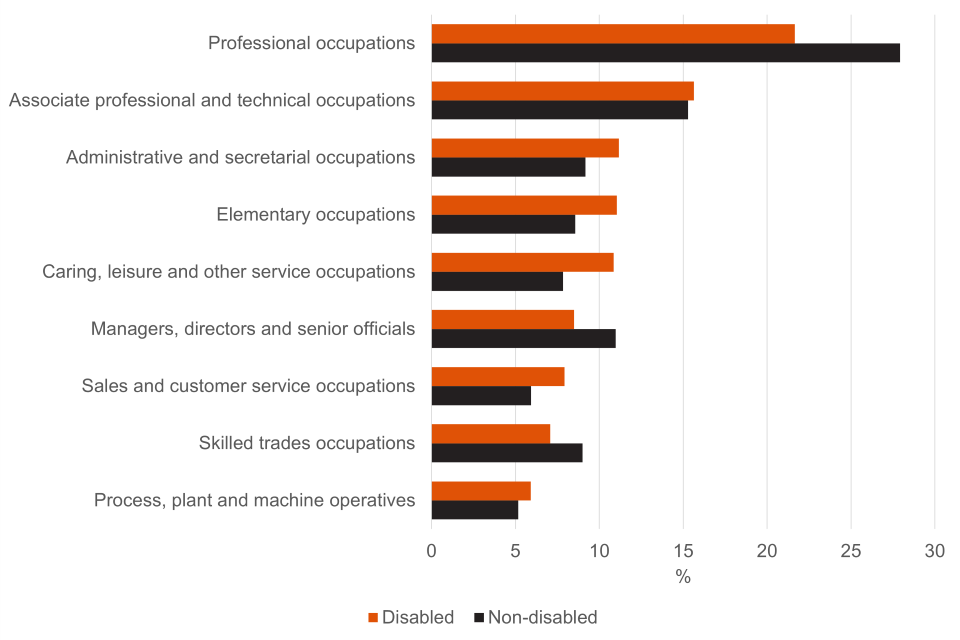
Source: Annual Population Survey – data and definitions can be found in supplementary data table EMP002.
Both disabled and non-disabled workers were most likely to be working in Professional occupations and least likely to be working as Process, plant and machine operatives in 2023/24.
Disabled workers were less likely to be in higher skilled occupations such as, Managers, directors and senior officials and Professional occupations compared with non-disabled workers. Although they were slightly more likely to be in Associate professional and technical occupations, than non-disabled workers. The proportion of disabled workers in these higher skilled occupations has increased over the past ten years, from 37.5% in 2013/14 to 45.8% in 2023/24.
Disabled workers were also more likely than non-disabled workers to be working in Caring, leisure and other service occupations; Elementary occupations; Administrative and secretarial occupations and Sales and customer service occupations than non-disabled workers. Conversely, the proportion of disabled workers in these occupations has decreased over the past ten years, from 44.8% in 2013/14 to 41.0% in 2023/24.
When analysing the age and sex demographics of disabled workers by occupation, the notable differences (which were also seen for non-disabled workers) were:
-
Elementary occupations (13.5% of disabled workers aged 16-34 compared to 9.9% of disabled workers 35-64)
-
Skilled trade occupations (13.7% of male disabled workers compared to 2.0% of female disabled workers)
-
Caring, leisure and other service occupations (4.5% of male disabled workers compared to 15.7% of female disabled workers)
Since 2013/14, the proportion of non-disabled people working in professional occupations has seen a larger increase compared to disabled people, who have seen a larger increase in people working in associate professional and technical occupations, largely driven by younger disabled people. The proportion of 16 to 34 year old disabled people working in associate professional and technical occupations increased by 6.7 percentage points since 2013/14, compared with 1.8 percentage points for 35 to 64 year olds.
Occupation data for 2020/21 and 2021/22 has been revised following a coding error identified in the collection of Standard Occupational Classification 2020 (SOC20) data for the Office for National Statistics (ONS) Labour Force and Annual Population Surveys. More information can be found at: Revision of miscoded occupational data in the ONS Labour Force Survey, UK - Office for National Statistics.
Disabled workers are more likely than non-disabled workers to be self-employed
Figure 23: Proportion of people in employment who are self-employed by disability status, employed people aged 16 to 64 years, UK, 2013/14 to 2023/24
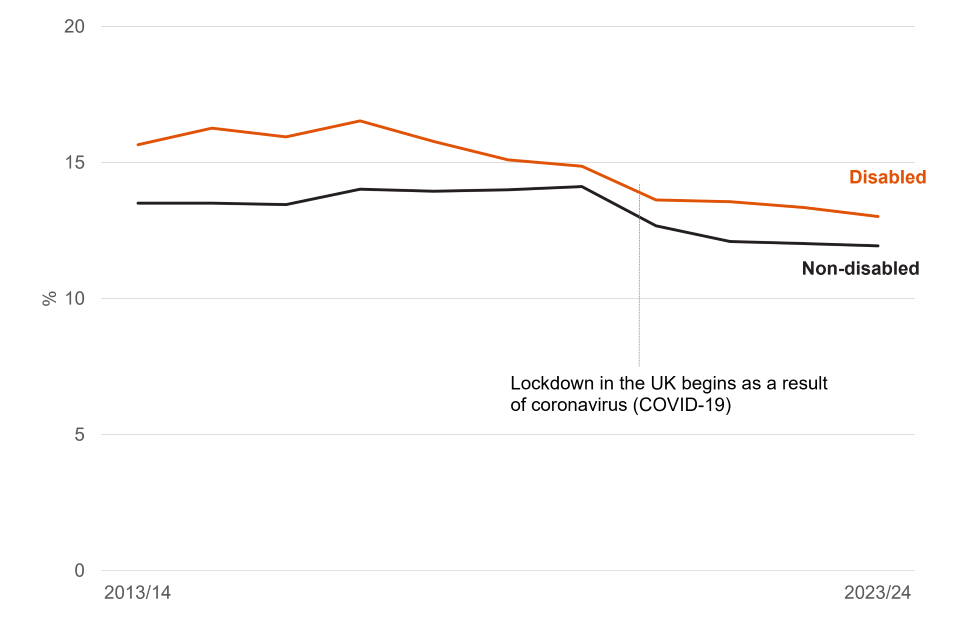
Source: Annual Population Survey – data and definitions can be found in supplementary data table EMP003.
The proportion of disabled workers who are self-employed has decreased by 2.6 percentage points from 15.7% in 2013/14 to 13.0% in 2023/24. This compares to non-disabled workers where the proportion has fallen by 1.6 percentage points from 13.5% to 11.9% over the same period.
The difference between the proportion of disabled and non-disabled workers who are self-employed decreased to a seven-year low (0.8 percentage points) in 2019/20. However, the difference stands at 1.1 percentage points in 2023/24, despite both the proportion of disabled and non-disabled people working in self-employment falling since 2019/20.
Falls in self-employment during the coronavirus (COVID-19) pandemic, for disabled and non-disabled workers, may in part be explained by a shift in people reclassifying themselves from self-employed to employees. This coincided with the introduction of the furlough scheme. The following article covers this in more depth: Understanding changes in self-employment in the UK - Office for National Statistics (ons.gov.uk).
One in three disabled workers are working part-time
Figure 24: Percentage of people in employment by disability status and working pattern, people aged 16 to 64 years, UK, 2023/24
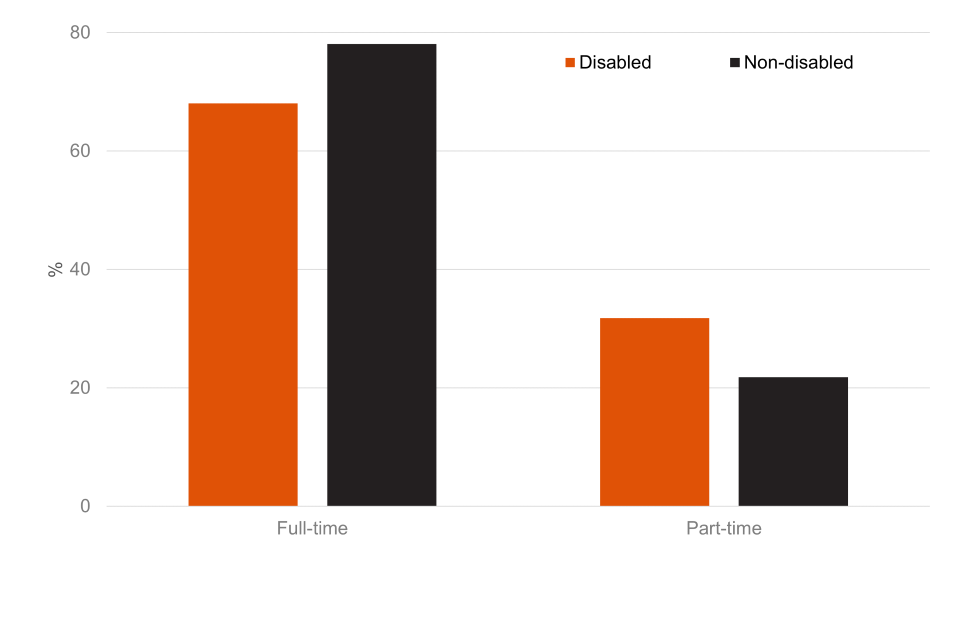
Source: Annual Population Survey – data and definitions can be found in supplementary data table EMP004.
Disabled workers are more likely to be working part-time, with 31.8% of disabled workers and 21.8% of non-disabled workers working part-time. Between 2013/14 and 2023/24 these proportions have decreased for both disabled and non-disabled workers. However, the proportion of workers working part-time has decreased more slowly (by 2.0 percentage points) for disabled workers than for non-disabled workers (by 2.8 percentage points, after rounding). This is consistent with the latest data (April-June 2024) showing disabled people work on average 4 hours less per week than non-disabled people.
The split between full-time and part-time employment is based on respondents’ self-classification.
Disabled workers are more likely to be employed in the public sector than non-disabled workers
Figure 25: Proportion of people in employment by disability status and sector, employed people aged 16 to 64, UK, 2023/24
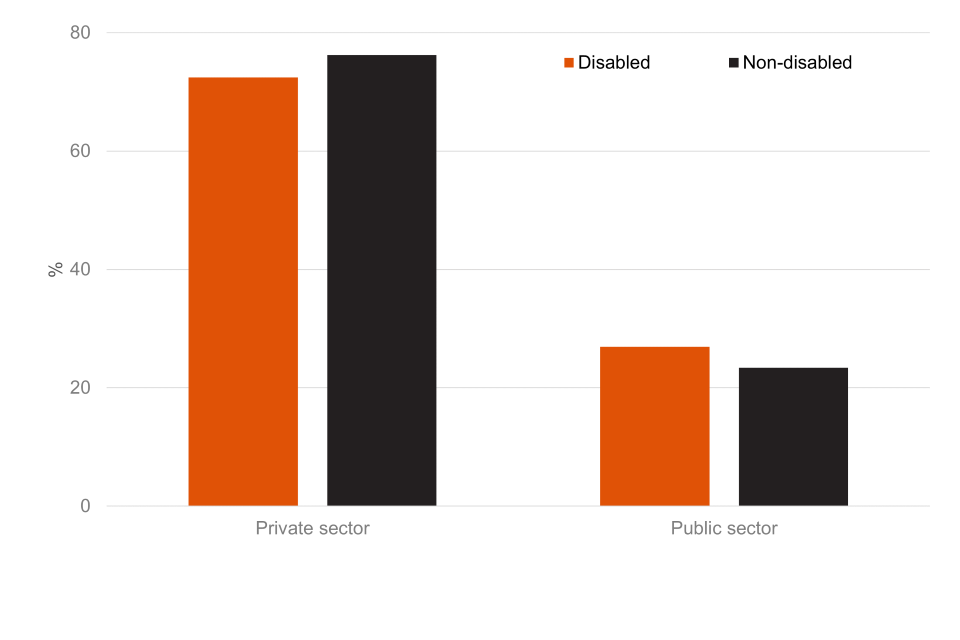
Source: Annual Population Survey – data and definitions can be found in supplementary data table EMP005.
Disabled workers are less likely to be working in the private sector than non-disabled workers and consequently more likely to be working in the public sector. For both disabled and non-disabled workers, around three times as many people work in the private sector compared to the public sector.
These patterns are related to the industries people work in (see supplementary data table EMP001). For example, disabled people are more likely to work in Human health and social work activities, Education and Public admin and defence and social security which are predominately public sector industries.
The proportion of disabled people working in the public sector remained relatively stable between 2014/15 and 2019/20 – 23.5% to 23.7%. In 2020/21 – the first year of the coronavirus (COVID-19) pandemic – the proportion increased to 26.5%. In 2023/24 the proportion was 26.9%, which is 3.2 percentage points above that seen prior to the pandemic. For more information on the classification of public and private sector, see Public sector or private sector: How the ONS decides – and why it matters.
Disabled employees are more likely to be working in small workplaces and less likely to be working in a large workplace
Figure 26: Proportion of people in employment by disability status and workplace size, employees aged 16 to 64, UK, 2023/24
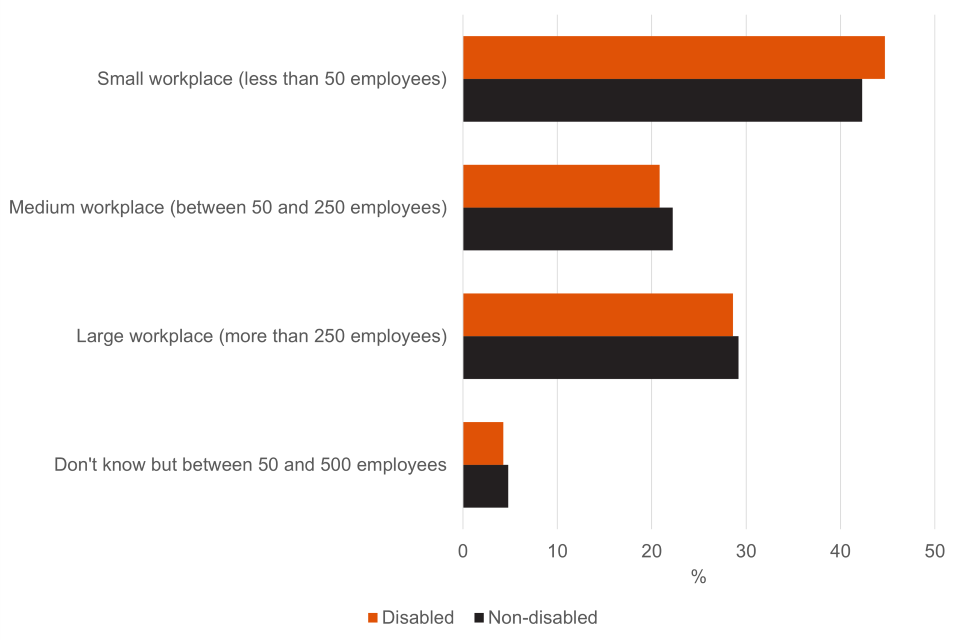
Source: Annual Population Survey – data and definitions can be found in supplementary data table EMP006.
Workplace size refers to the total number of employees at the respondent’s workplace, not just the section/department or the whole organization. In previous instalments of this publication this variable was referred to as ‘Employer size’, although the variable included in previous publications refers to the total number of employees at the respondent’s workplace. For more information, see the background information and methodology document.
Disabled employees (excluding people who are self-employed) are slightly more likely than non-disabled employees to be working in small workplaces and less likely to be working in a medium sized workplace. They were slightly less likely to work in a large workplace (although this was not statistically significant). This difference has decreased slightly in 2023/24 compared with 2022/23.
There has been a shift since 2014/15 with both disabled and non-disabled employees more likely to work in large workplaces and less likely to work in a small workplace. Small workplaces however still make up the largest group – 42.7% of all employees in 2023/24.
Disabled employees are more likely than non-disabled employees to be underemployed
The underemployment rate for disabled workers in April to June 2024 was 9.1% compared to 6.7% for non-disabled workers. There has been a fall of 0.9 percentage points (from 10.0%) for disabled workers (this change was not statistically significant) and 0.3 percentage points (from 7.0%) for non-disabled workers (this change was not statistically significant) compared to April to June 2023, which is the earliest comparable quarter available for this breakdown.
To be classed as underemployed, a person must either be looking for an additional job, looking for a new job with longer hours to replace their current (main) job, or wanting to work longer hours in their current job. In addition, they must also be available to start working longer hours within two weeks and their actual weekly hours worked must be 40 or less (for people aged under 18) or 48 or less (for people aged 18 and over).
Latest data shows that over 1.5 million working-age people had a long-term absence spell in the last 12 months. Data for those in employment experiencing long-term sickness absence (sickness absence lasting more than 4 weeks) by number of absence spells, length of absence and various characteristics are provided in the supplementary tables SAB001 to SAB003.
The data in this sub-section is originally sourced from the article Job quality indicators in the UK – hours, pay and contracts: 2021 published by the Office for National Statistics (ONS) in December 2022. The data is experimental and is the second exploratory analysis of the indicators of quality work. More information on the data, statistical significance, definitions and plans for future research can be found in the article.
This analysis does not constitute a government definition of quality work.
The ONS defined quality employment through different key measures:
-
satisfactory hours
-
low pay
-
desired contract
-
overtime
-
career progression
-
zero-hours contract
-
employee involvement
These are an expansion of the key measures, published in 2018, satisfactory hours, low pay and desired contract. The definitions of each key measure can be found in the background information and methodology.
Disabled employees compared with non-disabled employees are:
-
more likely to be in low pay (17% vs 12%)
-
less likely to have their desired contract (97% vs 98%)
-
more likely to be on a zero-hour contract (4% vs 3%)
-
less likely to have career progression opportunities (47% vs 57%)
-
less likely to report good employee involvement (47% vs 54%)
The quality of work indicators can also vary between disabled female and males. Disabled females tend to be more likely to have better quality work across different key measures.
Disabled employees are more likely to have low pay and fewer career progression opportunities than non-disabled employees
Figure 27: Proportion of female employees by disability status, quality of work indicator, people aged 16 to 64, UK, 2021
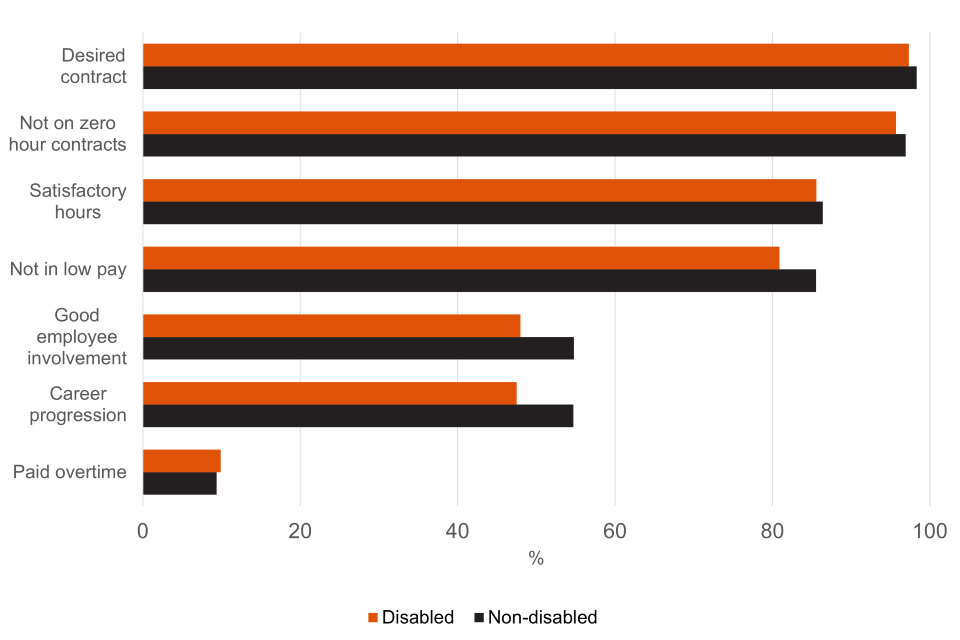
Source: Annual Population Survey – data and definitions can be found in supplementary data table EMP009.
Figure 28: Proportion of male employees by disability status, quality of work indicator, people aged 16 to 64, UK, 2021
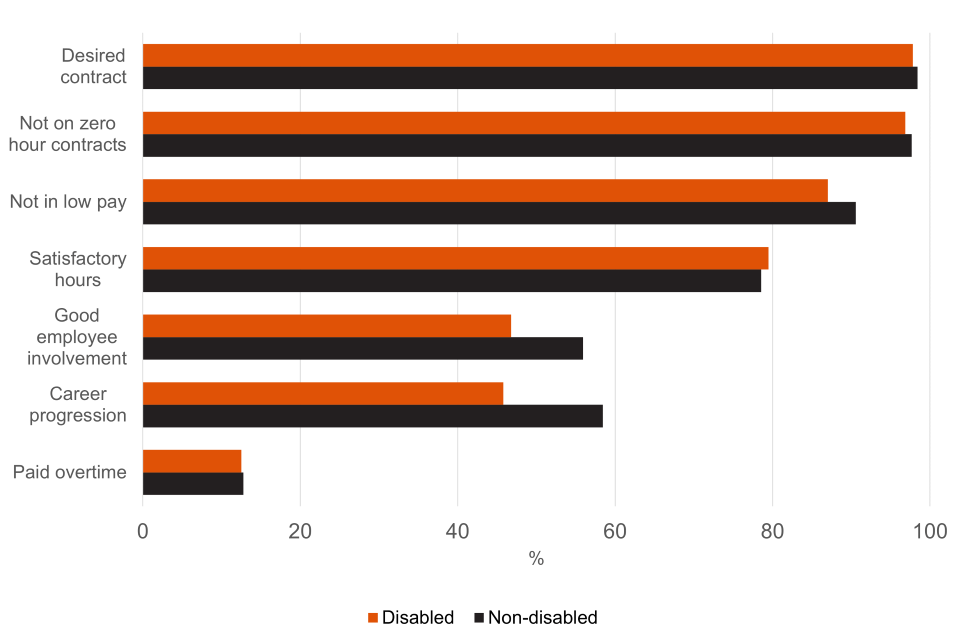
Source: Annual Population Survey – data and definitions can be found in supplementary data table EMP009.
Disabled female employees compared with disabled male employees are:
-
more likely to be working satisfactory hours (86% vs 79%)
-
more likely to be in low pay (19% vs 13%)
-
less likely to get paid overtime (10% vs 13%)
-
more likely to have career progression opportunities (48% vs 46%), this was not statistically significant
-
more likely to have good employee involvement (48% vs 47%), this was not statistically significant
-
more likely to be on a zero-hour contract (4% vs 3%), this was not statistically significant
Generally, these trends between males and females reflect the trends seen for non-disabled employees. However, non-disabled females are less likely to have opportunities for career progression or good employee involvement compared to non-disabled male employees, which is not the same trend for disabled employees.
Across the UK, disabled employees were more likely to be in low pay (17%) than non-disabled employees (12%). By sex, the proportion of employees in low pay was highest for disabled females (19%) and lowest for non-disabled males (9%).
The overall difference in reported career progression opportunities between disabled employees (47%) and their non-disabled colleagues (57%) appears to be driven by sex, with a 12-percentage point difference between disabled and non-disabled males (46% and 58% respectively), compared with only a 7-percentage point difference for females.
For more information on the associated confidence intervals and statistical significance of quality of work indicators, please refer to the Job quality indicator tables, UK published by the Office for National Statistics.
8. Economic inactivity
This section looks at differences between disabled and non-disabled people who are in economic inactivity
The number and percentage of economically inactive people classed as disabled has been rising since 2018/19 – after falling for three years in a row. The number increased by 0.6 million between 2018/19 and 2023/24 from 3.4 million to 4.1 million. The percentage increased by 6.5 percentage points from 38.7% to 45.2% over the same period. In the last year, the number of economically inactive people who were disabled rose by 30,000 (or 0.6 percentage points) (although this increase was not statistically significant), the rate of this increase has slowed in comparison to the previous year.
Similarly, the number and percentage of working-age people who state the main reason for being economically inactive as long-term sickness, also continues to rise, but the rate of increase has slowed in the most recent year. This figure was 2.8 million in April-June 2024, 107,000 higher than estimates a year ago, although this increase is not statistically significant. The previous year-on-year increase to April-June 2023 was 311,000.
A range of complex and interacting factors could be driving the rise in long-term sickness, as the main reason for being economically inactive, including NHS waiting lists, long COVID and changes in the demographics and health of the population.
The following Office for National Statistics (ONS) articles cover this in more depth:
-
Half a million more people are out of the labour force because of long-term sickness
-
Rising ill-health and economic inactivity because of long-term sickness, UK
In the second article the ONS say that “Long-term, self-reported ill health has been rising across the working-age population, especially since the onset of the coronavirus (COVID-19) pandemic. Also, between 2019 and 2022, the percentage of people who reported a long-lasting health condition that limits either the kind or amount of work they can do rose from 16.4% to 18.1%, and this rise in the work-limiting health conditions was the largest contributing factor to the rise in economic inactivity. For those individuals suffering with long-term health conditions who were in employment, the sickness absence rate in 2022 was 4.9%, the highest it has been since 2008 compared with 1.5% for those in employment without a long-term health condition. Changes in the age composition of the population are one important contribution to long-term sickness volumes with the large number of “baby boomers” approaching retirement. It is estimated that around 40,000 extra people would be expected to become inactive because of long-term sickness between 2019 and 2022 as a result of these changes, although the actual change during this period was much larger (462,000).”
The NHS referral to elective treatment waiting list in England, which increased from 4.4 million in January 2020 to 7.6 million in July 2024, may also have contributed to this increase. The Opinions and Lifestyle Survey on winter pressures found that between 18th October 2023 and January 1st 2024, 34% of those inactive (excluding retired) were waiting for NHS treatment, of which 36% said it had “strongly impacted” their lives, 74% said it had affected their wellbeing and 45% said it had affected their mobility.
During the same time period, for those of working age (16-64), 33% of people who were economically inactive (excluding retired) were on NHS waiting lists in comparison to 19% of those who were either employed or self-employed.
However, analysis published by the Office for Budget Responsibility (OBR) in July 2023 states that “the rising NHS waiting list itself looks unlikely to have been a significant causal driver of rising long-term sick inactivity in recent year”. One reason for this is that “there appears to be limited correlation in waiting list trends by age and ‘treatment function’ between mid-2021 and the end of 2022 and concurrent changes in inactivity due to long-term sickness.”
Nearly three in every five economically inactive disabled people give long-term sickness as the main reason for being inactive
Figure 29: Proportion of economically inactive people by main reason and disability status, people aged 16 to 64, UK, 2023/24
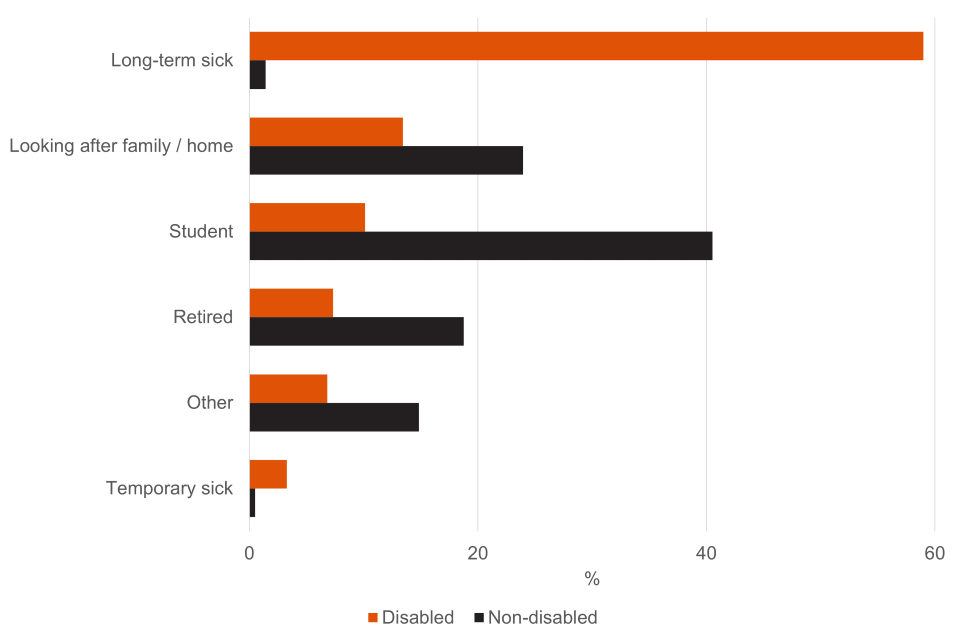
Source: Annual Population Survey – data and definitions can be found in supplementary data table EIA001.
Long-term sickness is the main reason given by disabled people for being economically inactive (59.0% in 2023/24). This has remained stable over the last ten years (57.4% in 2013/14). The next three largest reasons given in 2023/24 were looking after family/home (13.4%), being a student (10.1%) and retirement (7.3%).
Economically inactive non-disabled people were more likely to state their main reason for being inactive as being a student (40.5%), looking after family/home (23.9%) and retirement (18.8%), with only 1.4% stating long-term sickness.
Conversely, 96.4% of people who gave long-term sickness as their main reason for being economically inactive in 2023/24 were disabled. This has remained stable at around 96% over the past ten years. This compares to looking after family/home (31.9% were disabled) and being a student (17.2% were disabled), where the proportions who are disabled have increased by 10.8 and 8.2 percentage points respectively since 2013/14, and retirement which has decreased by 4.1 percentage points (24.6% were disabled).
For all economically inactive people the increase in the percentage classed as disabled between 2013/14 and 2023/24 was 9.1 percentage points.
Economically inactive people are more likely to want a job if they are disabled
Figure 30: Proportion of economically inactive people who want a job by disability status, economically inactive people aged 16 to 64, UK, 2013/14 to 2023/24
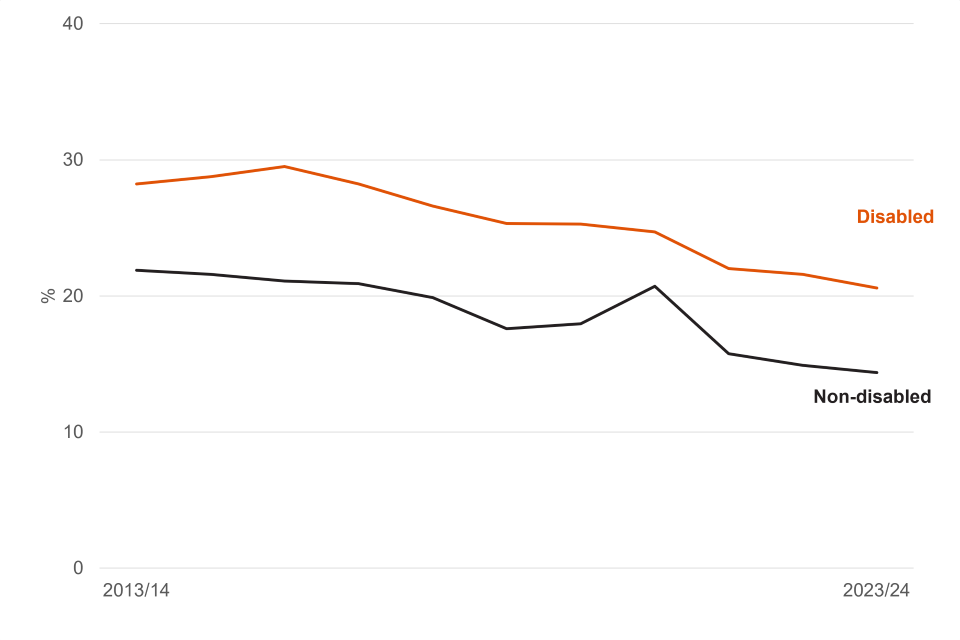
Source: Annual Population Survey – data and definitions can be found in supplementary data table EIA002.
The proportion of economically inactive disabled people who wanted a job in 2023/24 was 20.6%. This compares to economically inactive non-disabled people where the equivalent figure was 14.4%. This may be explained by the reasons disabled and non-disabled people are more likely to give for being inactive (see Figure 29). Disabled people are less likely to be a student or retired, but these groups together, regardless of disability status, make up nearly half of all those who say they do not want a job (see supplementary data table EIA004 for figures by main reason for inactivity).
The proportions have generally fallen, for both disabled and non-disabled people, over the past ten years but the difference between the two is similar in 2023/24 (6.2 percentage points) as in 2013/14 (6.3 percentage points). The rate decreased by 1.0 percentage point for disabled people from 2022/23 to 2023/24 and 0.5 percentage points for non-disabled, this change was not statistically significant.
This follows a decrease between 2020/21 and 2021/22, which was larger than in any other year since 2013/14. This was 2.7 percentage points for disabled people and 5.0 percentage points for non-disabled people (after rising during the first year of the coronavirus (COVID-19) pandemic).
Economically inactive disabled people are less likely to have had a job in the last two years
Figure 31: Proportion of economically inactive people by when left last job, age and disability status, people aged 16 to 64, UK, 2023/24
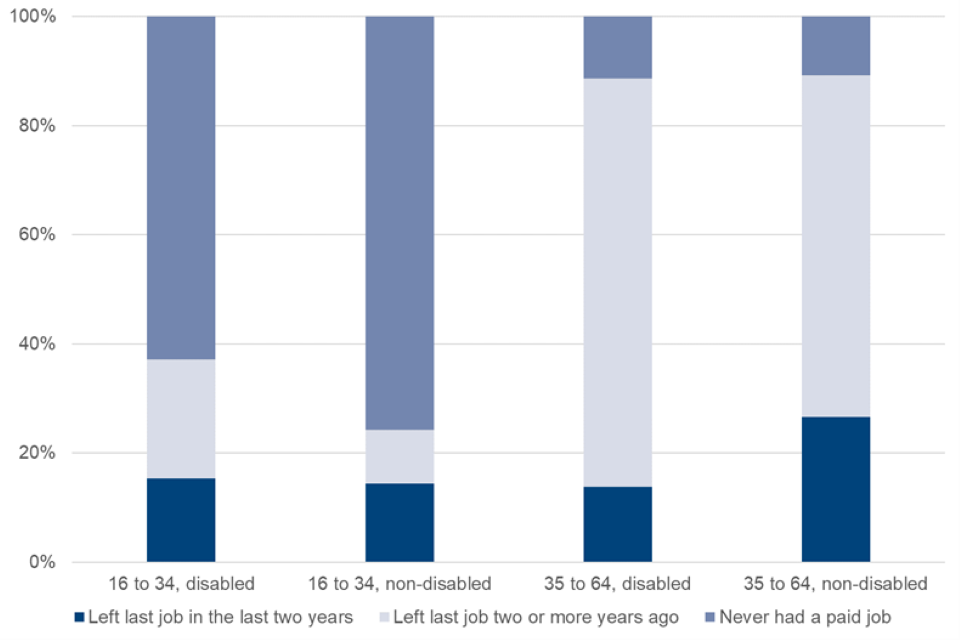
Source: Annual Population Survey – data and definitions can be found in supplementary data table EIA003.
In 2023/24, 57.5% of economically inactive disabled people had left their last job two or more years ago compared to 34.1% of economically inactive non-disabled people.
Economically inactive disabled people were less likely to have never had a paid job (27.1% compared to 45.2% for non-disabled people). However, they were less likely to be younger (31.2% are aged 16 to 34 compared to 53.6% of non-disabled people) and were less likely to give the main reason for being inactive as being a student (see Figure 29). This means that non-disabled people were more likely to still be in full-time education and may not yet have entered the labour market. This may partly explain why they are more likely to have never had a paid job.
As Figure 31 shows, for economically inactive people aged 16 to 34, disabled people were more likely to have left their last job two or more years ago (21.6% compared to 9.8%) but less likely to have never had a paid job (62.3% v 75.1%) compared to non-disabled people. For the 35-to 64-year-old age group, disabled people were again more likely to have left their last job two or more years ago (73.7% v 62.3%) and were similarly as likely to have never had a job (11.2% v 10.6%). Around one in ten of both disabled and non-disabled people aged 35 to 64 who are economically inactive have never had a paid job.
Most economically inactive disabled people give long-term sickness as their main reason for being inactive. Data specifically for this group can be found in supplementary data tables EIA012 to EIA021.
9. Wellbeing
This section looks at the average wellbeing scores of four key indicators for disabled people in and out of employment. It expands on the Outcomes for disabled people in the UK: 2021 which reported that disabled people aged 16 to 64 years had poorer ratings of wellbeing than non-disabled people on all four personal wellbeing measures (year ending 2021).
Wellbeing can be defined through four different key measures:
-
Worth: Overall, the extent to which people feel like the things they do in their life are worthwhile
-
Satisfaction: Overall, how satisfied people are with their life nowadays
-
Happiness: How happy people felt the previous day
-
Anxiety: How anxious people felt the previous day
This measure is subjective and each wellbeing question is answered by the respondent on a scale of 0 to 10. See the background information and methodology for more information.
To derive estimates of anxiety, respondents were asked “Overall, how anxious did you feel yesterday? Where 0 is ‘not at all anxious’ and 10 is ‘completely anxious’”. This differs to other wellbeing measures where a higher score indicates higher levels of wellbeing.
Figure 32: Average wellbeing scores of people by disability status, people aged 16 to 64, UK, 2023/24
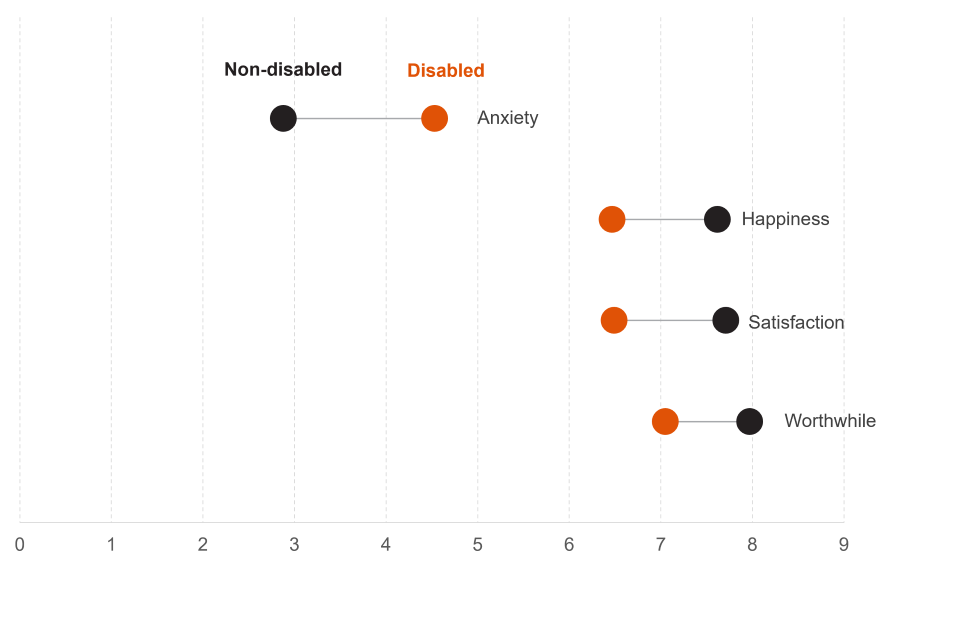
Source: Annual Population Survey – data and definitions can be found in supplementary data table WEL001.
Note: To derive estimates of anxiety, respondents were asked “Overall, how anxious did you feel yesterday? Where 0 is ‘not at all anxious’ and 10 is ‘completely anxious’”. This differs to other wellbeing measures where a higher score indicates higher levels of wellbeing.
The latest data shows that disabled people aged 16 to 64 years, both in and out of employment, have lower average wellbeing scores and higher average anxiety scores compared to those who were non-disabled. Average wellbeing scores were even poorer for disabled people not in employment.
The largest disparity is for disabled people who felt anxiety the previous day compared to non-disabled people in and out of employment. The largest difference was for disabled people who were not in employment who had higher levels of anxiety on average, with a score of 4.91 compared with 2.87 for non-disabled people who were in employment.
Figure 33: Average wellbeing scores of disabled people by employment status, people aged 16 to 64, UK, 2023/24
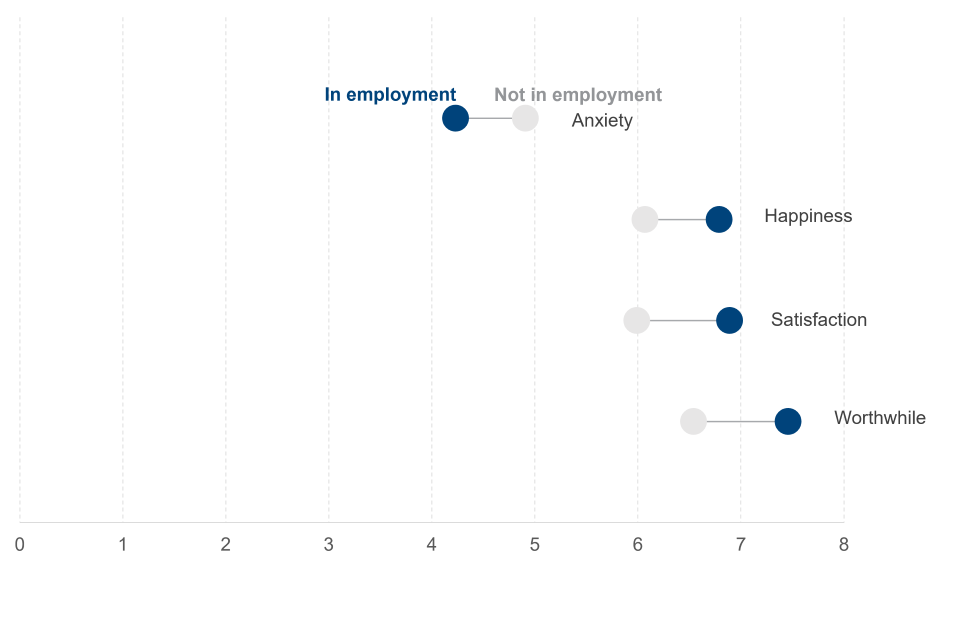
Source: Annual Population Survey – data and definitions can be found in supplementary data table WEL001.
Note: To derive estimates of anxiety, respondents were asked “Overall, how anxious did you feel yesterday? Where 0 is ‘not at all anxious’ and 10 is ‘completely anxious’”. This differs to other wellbeing measures where a higher score indicates higher levels of wellbeing.
In 2023/24, disabled people who were in employment were on average more likely to have higher ratings of personal wellbeing and lower average levels of anxiety compared to those who were not in employment. There was little difference in overall wellbeing scores, including for anxiety scores, for non-disabled people who were in employment compared to those who were not in employment.
Between 2013/14 and 2023/24 happiness measure scores have generally remained steady for both non-disabled and disabled people, however the average anxiety score for disabled people has increased from 4.10 to 4.53 (3.75 to 4.23 for those in employment and 4.38 to 4.91 for those not in employment.
Figure 34: Difference in wellbeing scores of disabled people in employment compared with disabled people not in employment by main health condition, people aged 16 to 64, UK, 2023/24
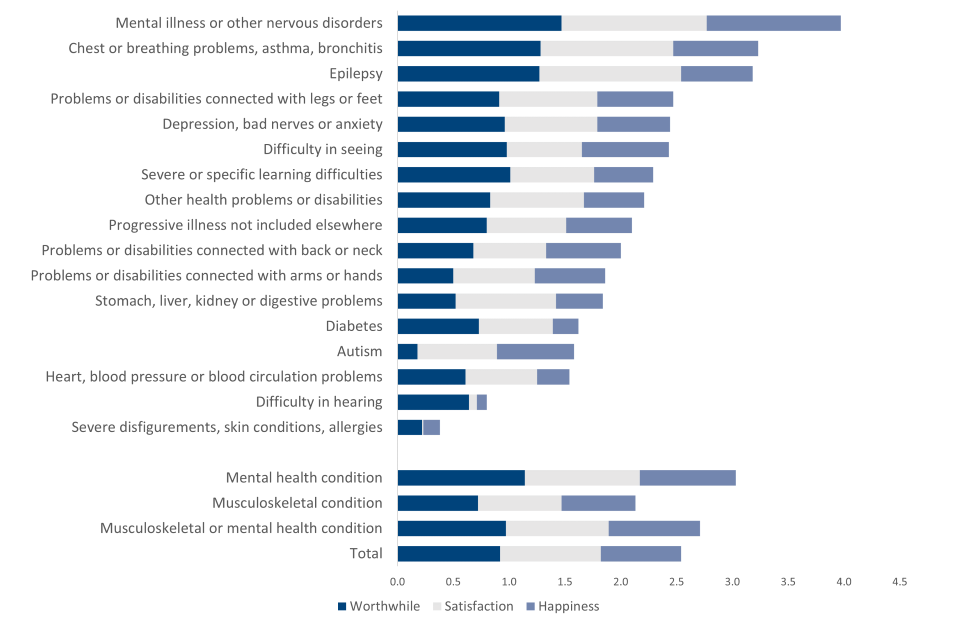
Source: Annual Population Survey – data and definitions can be found in supplementary data table WEL001.
Wellbeing measures can vary between disabled people who are in employment and disabled people who are out of employment by health condition.
Some of the key differences by main health condition:
-
average worthwhile, satisfaction and happiness wellbeing score for people with a main health condition that is mental illness or other nervous disorders (worthwhile in employment 7.11 v 5.64 not in employment, satisfaction in employment 6.28 v 4.98 not in employment, happiness in employment 6.11 v 4.91 not in employment)
-
despite anxiety scores generally being lower across for disabled people in employment across most main conditions, disabled people with severe or specific learning difficulties who were in employment were more likely to feel anxious (5.13) compared with those not in employment (3.58)
Many disabled people have more than one health condition which may limit their activity, that won’t be captured in the analysis of their main health condition. Some changes over time in main condition may reflect changes in the relative impacts of pre-existing conditions rather than the onset of new conditions. Average wellbeing scores may be different when looking at main and secondary condition compared to main condition alone. See supplementary table WEL004 for average wellbeing scores by main or secondary condition.
For most positive measures of wellbeing, average scores decrease when there is an increase in the number of health conditions an individual has. The impact of the number of health conditions on wellbeing scores is more pronounced for disabled people who are not in employment compared with disabled people who are in employment.
Disabled people with a main condition that is a musculoskeletal condition are more likely to have more positive measures of wellbeing compared with those with a mental health condition.
Further data for wellbeing scores by various characteristics such as ethnicity, highest qualification, local authority, age, and sex are provided in supplementary tables WEL001 to WEL016 should alternative breakdowns be required.
10. Flows
This section focuses mainly on the movements, or flows, between employment status (in work or not in work) from one year to the next. People not in work will be either unemployed or economically inactive.
Employment status is measured a year apart so will not include movements within the year. For example, a person may be in employment when they complete the survey in the first year, move out of employment (and then back in) and be in employment when they are surveyed the following year. In this scenario the person would be classed as having remained in employment. The same situation will apply to changes in disability status. Cases where the person moves from or to and unknown disability status are excluded from the data.
Estimates are generally averaged over more than one year to increase precision.
In general, disabled people are more likely to move out of work and less likely to move into work, compared to non-disabled people, over the course of a year.
-
on average, between 2014 and 2019, around 340,000 disabled workers moved out of work each year and 380,000 workless disabled people moved into work (includes people who were classed as disabled at the start of the year)
-
this trend was reversed in 2020 and 2021 when more disabled people moved out of work than into work, but in 2022 480,000 workless disabled people moved into work compared to 450,000 disabled workers moving out of work. In 2023, the difference in disabled people entering and leaving work has widened as 480,000 workless disabled people moved into work compared with 380,000 disabled workers moving out of work
-
on average, between 2014 and 2023, disabled workers moved out of work at nearly twice the rate (8.6%) of non-disabled workers (4.9%). Workless disabled people moved into work at nearly one-third of the rate (10.1%) of workless non-disabled people (27.2%)
Nearly one in three people classed as being disabled one year were no longer classed as being disabled the next
Figure 35: Flows between disability and employment status, people aged 16 to 64 years, UK, 2014 to 2023
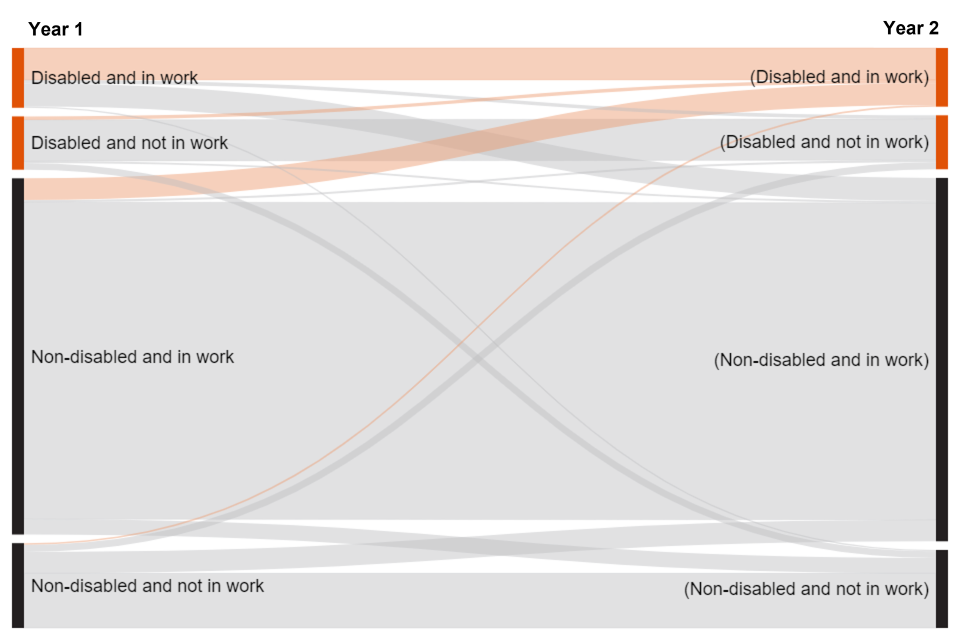
Source: Annual Population Survey – data and definitions can be found in supplementary data table FLW001.
Figure 35 shows how people move between the different disability and employment states from one year to the next. This is taken as an average between 2014 and 2023 with the thickness of the line representing the number of people. The largest group is non-disabled people who are in work one year, and still in work and classed as non-disabled the next.
Nearly one in three (29.1%) people classed as being disabled one year were no longer classed as being disabled the next. This suggests that disability is not static and that it can change. For disabled people in work one year, 91.4% are still in work the following year. Of these, 42.0% are no longer classed as being disabled. For disabled people who are out of work one year and still out of work the following year, 13.9% are no longer classed as disabled which suggests that people are more likely to change their status from disabled to non-disabled if they are in work.
The orange lines in Figure 35 show the disability and employment status in year one of all the disabled people who were in work in year two. The majority (59.8%) of them are disabled people who have remained in work (53.6%) or moved into work (5.9%). The other 40.2% are non-disabled people who have remained in work (36.8%) or moved into work (2.9%) and are now classed as disabled.
Disabled workers are twice as likely to move out of work if they are working part-time
Figure 36: Proportion of people moving out of work by disability status and working pattern, employed people aged 16 to 64 years, UK, 2014 to 2023
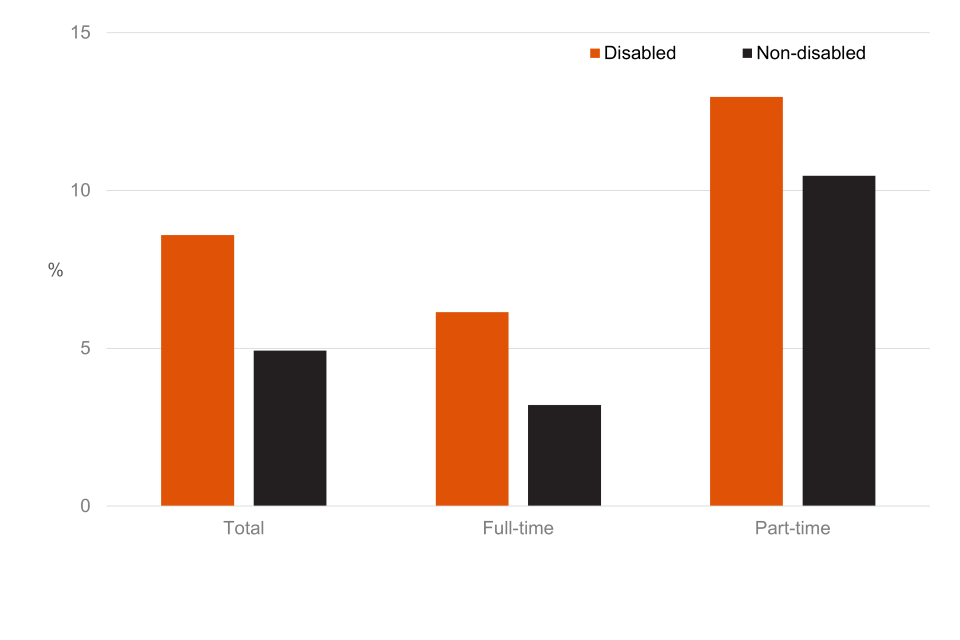
Source: Annual Population Survey – data and definitions can be found in supplementary data table FLW002.
We know that disabled workers were more likely to be in part-time employment compared with non-disabled people (see ‘Employment’ section and supplementary data table EMP004).
Disabled workers in part-time employment were twice as likely (13.0%) to move out of work compared to those working full-time (6.1%) between 2014 and 2023.
A similar pattern can be seen for non-disabled workers but to an even greater extent. Non-disabled workers in part-time employment were three times (10.5%) more likely to move out of work than those in full-time employment (3.2%).
Unlike in Figure 35, disability status is measured in the first year regardless of whether it changes the following year.
Disabled people are more likely to move both in and out of work if their main health condition is a mental health condition
Figure 37: Proportion of flows by employment status and main health condition, disabled people aged 16 to 64, UK, 2014 to 2023
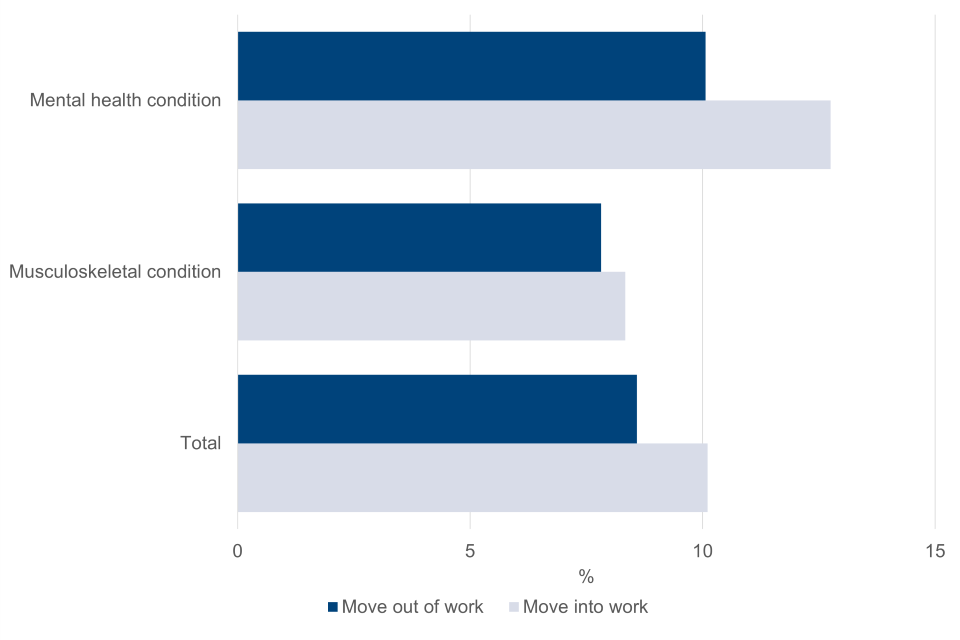
Source: Annual Population Survey – data and definitions can be found in supplementary data tables FLW003 and FLW004.
Musculoskeletal (MSK) conditions include problems or disabilities connected with the arms, hands, legs, feet, back or neck. Mental health (MH) conditions include depression, bad nerves, anxiety, mental illness or other nervous disorders.
On average between 2014 and 2023, disabled people were more likely to move both in and out of work if their main condition was a mental health condition compared to those where the main condition was musculoskeletal:
-
12.8% of those not in work the previous year with a mental health condition moved into work compared to 8.3% for those with a musculoskeletal condition
-
10.1% of those in work the previous year with a mental health condition moved out of work compared to 7.8% for those with a musculoskeletal condition
This is not unexpected given disabled people with a mental health condition are more likely to be in the younger age groups (see supplementary data table POP002) and these age groups are more likely to move in and out of work (see supplementary data table FLW005).
Estimates for some health conditions are based on small sample sizes and therefore subject to a higher degree of uncertainty. The data for all health conditions can be found in supplementary data table FLW003. The equivalent data for main or secondary health conditions can be found in supplementary data table FLW004. Unlike in Figure 35 disability status is measured in the first year regardless of whether it changes the following year.
Figure 38: Flows between disability and employment status, students in full-time education aged 18 to 24 years, UK, 2014 to 2023
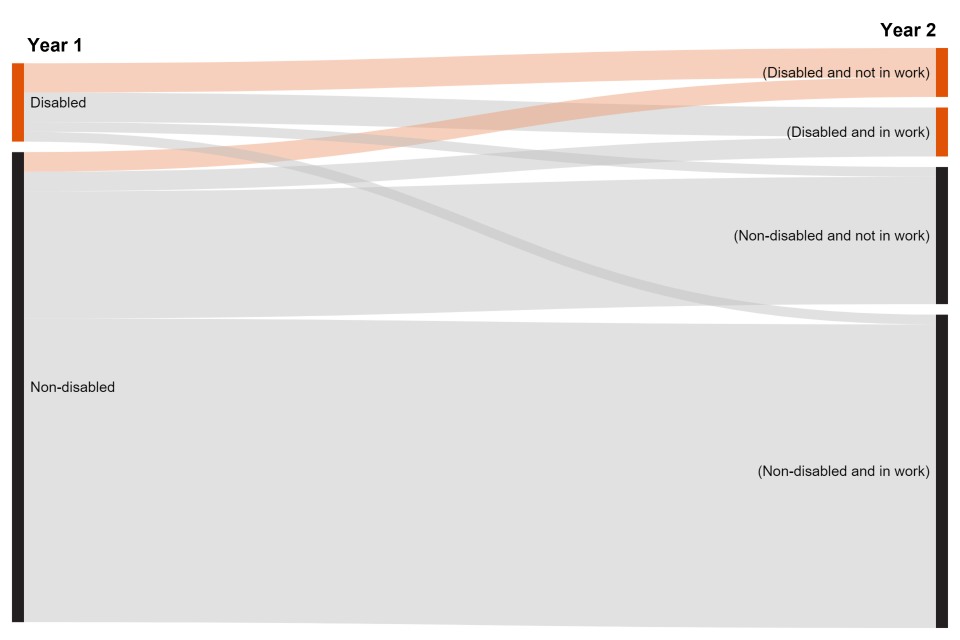
Source: Annual Population Survey – data and definitions can be found in supplementary data table FLW010.
In 2023/24, nearly a quarter (22.9%) of people aged 18 to 24 years were economically inactive because they were a student. Between 2014 and 2023, on average 560,000 18 to 24 years were economically inactive due to being a student in one year then no longer economically inactive due to being a student the next year. Disabled people who were economically inactive students were less likely to move into employment (43.4%) compared with non-disabled people (69.1%).
Additional flows data for the disabled and non-disabled working age population by age, sex and highest qualification can be found in supplementary data tables FLW005 to FLW007.
11. About these statistics
These statistics have been compiled using data from the Labour Force and Annual Population surveys which are produced by the Office for National Statistics (ONS). They follow the same definitions and UK coverage used in the ONS Labour Market Overview They have been developed using guidelines set out by the UK Statistics Authority and are badged as Official Statistics.
Where to find out more
For more information see:
-
guidance about the background and methodology of the Labour Force Survey (LFS) and Annual Population Survey (APS)
Office for Statistics Regulation
Our statistical practice is regulated by the Office for Statistics Regulation (OSR). OSR sets the standards of trustworthiness, quality and value in the Code of Practice for Statistics that all producers of official statistics should adhere to.
You are welcome to contact us directly with any comments about how we meet these standards.
Alternatively, you can contact OSR by emailing regulation@statistics.gov.uk or via the Office for Statistics Regulation website.
Statement of compliance with the Code of Practice for Statistics
The Code of Practice for Statistics (the Code) is built around three main concepts, or pillars:
-
Trustworthiness – is about having confidence in the people and organisations that publish statistics
-
Quality – is about using data and methods that produce assured statistics
-
Value – is about publishing statistics that support society’s needs for information
The following explains how we have applied the pillars of the Code in a proportionate way.
Trustworthiness
Labour Force Survey, Annual Population Survey data have been produced in line with the Code.
The ongoing challenges with response rates and levels mean that ONS publish Labour Force Survey-based labour market statistics as official statistics in development until further review. This is also in line with the letter from the Office for Statistics Regulation (OSR), stating that LFS statistics should not be published as accredited official statistics until the OSR has reviewed them.
Quality
Several of the key series have been taken directly from a National Statistics publication (Labour Market Overview), produced by the Office for National Statistics (ONS). The data sources used for new analysis in this release are already used for similar analyses and are considered Official statistics in development by ONS. The specific analyses included here have been quality-assured, including through peer-review, plausibility checks and validation against other published sources.
Value
This release provides a detailed picture of disability employment up to 2024.
Making this information accessible provides ministers and stakeholders with an overview of disability employment, while helping to reduce the administrative burden of answering Parliamentary Questions, Freedom of Information requests and ad hoc queries.
By comparing high-level estimates from different data sources, this release also provides an evidence base drawing on several different sources, enabling a more rounded picture of broad trends.
Related Statistics
The following publications provide additional data, evidence and context on the topics of health, disability and employment.
Access to Work recipients: Statistics on the number of people who had Access to Work provision approved.
Adult Psychiatric Morbidity Survey: Provides data on the prevalence of both treated and untreated psychiatric disorder in the English adult population (aged 16 and over).
Adult Social Care Outcomes Framework (ASCOF): Measures how well care and support services achieve the outcomes that matter most to people.
Benefit recipients during the coronavirus (COVID-19) pandemic: Age-standardised percentages of people who received a social security benefit by health conditions and sociodemographic characteristics, using linked 2011 Census, primary care and benefits data.
Benefit recipients during the coronavirus (COVID-19) pandemic by health condition or sociodemographic characteristic, local authority and benefit type, England, November 2019 to March 2021: Numbers and percentages of people who received a social security benefit from November 2019 to March 2021 by health condition or sociodemographic characteristic, local authority and benefit type, using linked Census 2011, primary care and benefits data. Official statistics in development.
Coronavirus and the social impacts on disabled people in Great Britain: Indicators from the Opinions and Lifestyle Survey on the social impact of the coronavirus (COVID-19) pandemic on disabled people in Great Britain.
Disability, England and Wales: Census 2021: Information on disability in England and Wales, Census 2021 data.
DWP benefits statistics: National and Official statistics on the main benefits administered by the DWP.
Economic labour market status of individuals aged 50 and over: This publication details the trends over time, and comparisons with 35 to 49-year-olds, in the economic labour market status of individuals aged 50 and over.
Family Resources Survey: An annual report that provides facts and figures about the incomes and living circumstances of households and families in the UK.
Health Survey for England: Monitors trends in the nation’s health and care for adults aged 16 and over, and children aged 0 to 15, living in private households in England.
Households below average income (HBAI) statistics: Statistics on the number and percentage of people living in low-income households in the UK.
Labour market status of disabled people: Labour market status (employment, unemployment and inactivity) of disabled people. This table is updated 4 times a year in February, May, August and November. These estimates are sourced from the Labour Force Survey, a survey of households.
NHS Talking Therapies Monthly Statistics including Employment Advisors: This statistical release makes available the most recent NHS Talking Therapies for anxiety and depression monthly data, including activity, waiting times, and outcomes such as recovery.
Odds ratios for benefit receipts during the coronavirus (COVID-19) pandemic, England: 23 March 2020 to 31 March 2021: Regression analysis of people who received a social security benefit from 23 March 2020 to 31 March 2021, among people who had not received a benefit from 1 November 2019 to 22 March 2021, by health conditions and sociodemographic characteristics, using linked Census 2011, primary care and benefits data.
Outcomes for disabled people in the UK: Outcomes for disabled people across areas of life: education, employment, social participation, housing, well-being, loneliness and crime. Analysis by disability status and by age, sex, impairment type and severity, country and region based on survey data.
Personal Independence Payment: Includes numbers of claims in payment, new claim registrations, decisions and awards made.
Unpacking the Disability Employment Gap, University of Sheffield: A 3-year project, conducted by the University of Sheffield, investigating the gap in employment between disabled and non-disabled people in the UK.
Work and Health Programme: Statistics on people referred to and starting on the Work and Health Programme.
Contact information and feedback
Authors: Aniysa Ruhi, Harjeevan Singh Johal and Mark Burley
Lead Analyst: Caroline Parker-Smith
For more information on disability employment statistics, contact the team by email workandhealthanalysis@dwp.gov.uk
Media enquiries should be directed to the DWP Press Office.
Pre-release access
In addition to staff who are responsible for the production and quality assurance of the statistics, up to 24-hour pre-release access is provided to Ministers and other officials. We publish the job titles and organisations of the people who have been granted up to 24-hour pre-release access to the latest employment of disabled people statistics.
Next release
The next annual release of these statistics is expected in Autumn 2025. An exact publication date will be listed in the statistics release calendar.
ISBN: 978-1-78659-760-1
